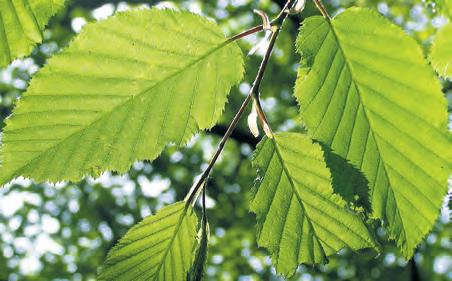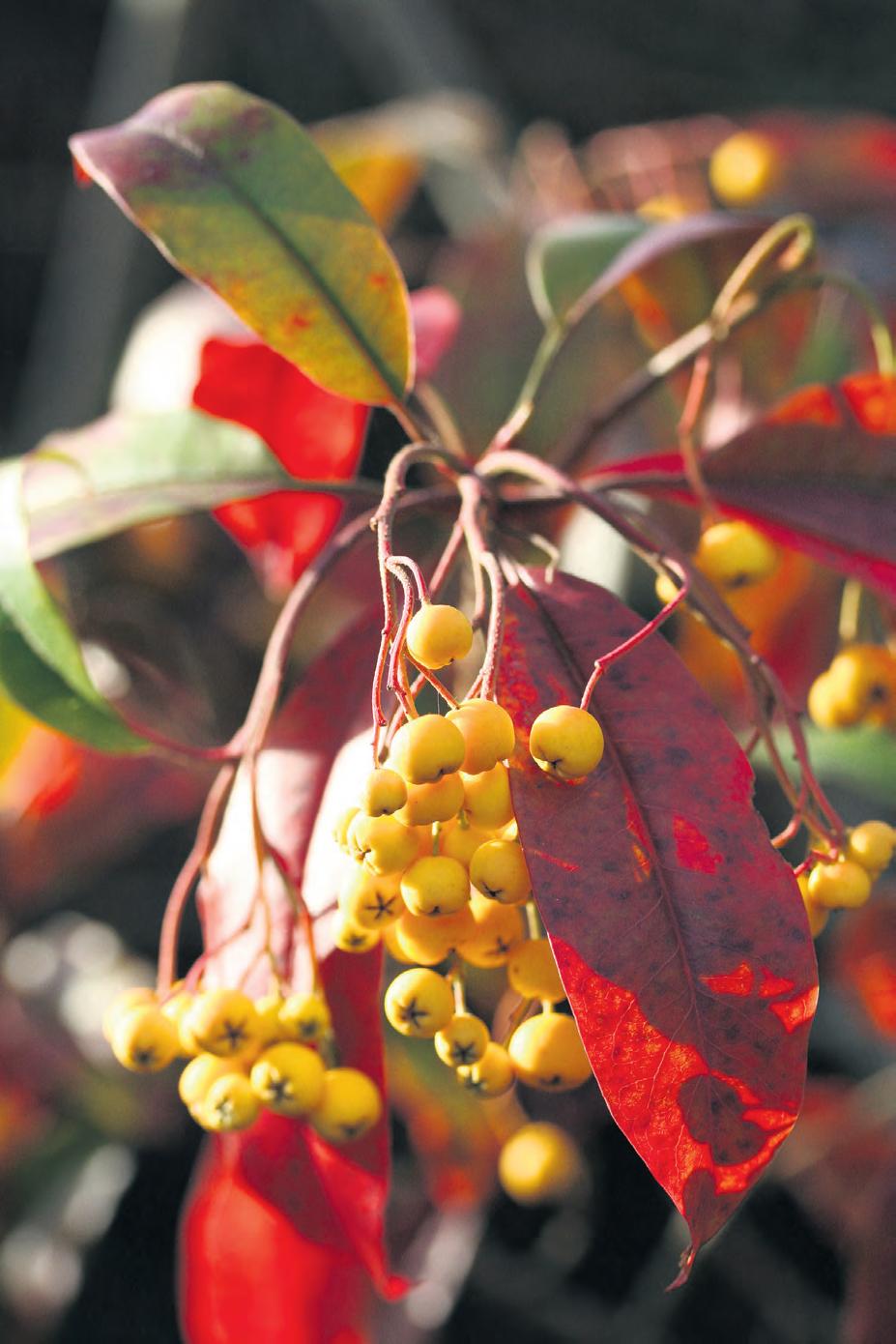






for a bloom of spring colour with
biggest range of bulbs now in


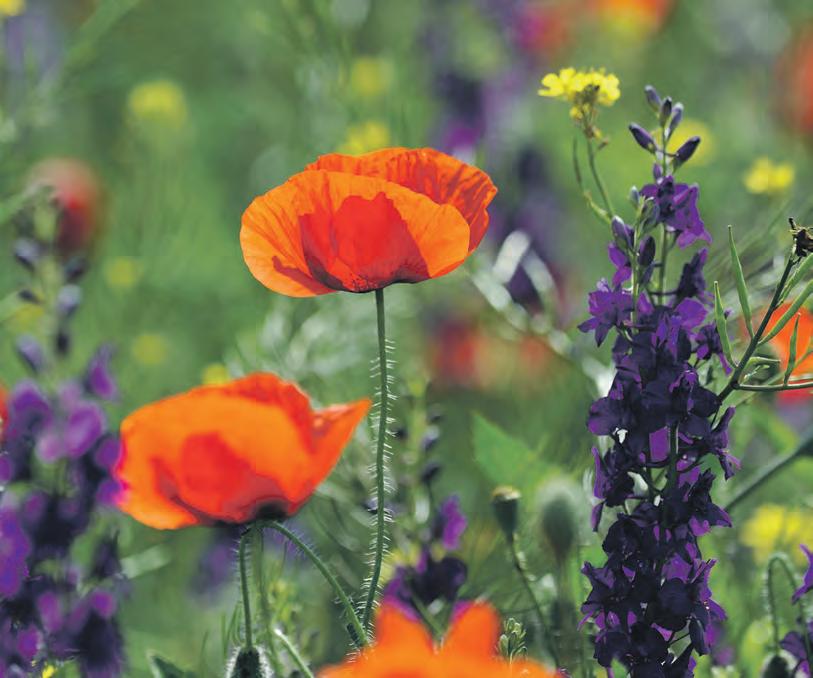
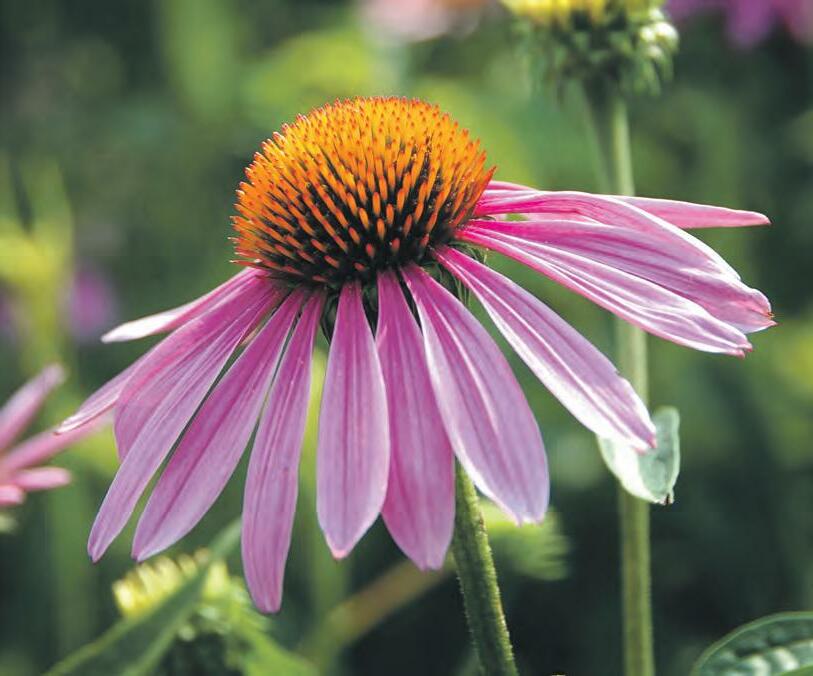









Christmas shopping comes early to historic Poltimore House near Exeter when its Christmas fair is held on Sunday 27th November - and weather permitting you can get some fresh air to explore the grounds.
With many stalls in both the house and the chapel this is one of Poltimore’s most popular events. Products range from high quality gifts to pocket money items, and there will be lots of seasonal decorations on offer as well.
The fair opens at 10.30am and closes at 3pm. Admission is £3. Set in just over 13 acres the house is managed by two charities, Poltimore House Trust and Friends of Poltimore House.
The walk around the grounds may be muddy, so waterproof shoes are recommended.
Poltimore House, Exeter
0AU. www.poltimore.org
Over the next few weeks there’s the chance to soak oak up the changing of the season with a free family trail around the gardens and grounds of NT Coleton Fishacre in Kingwear.
The autumn trees and a special autumn trail around the National Trust property gardens that are at their best for many years. Hunt for the bright colours of autumn, listen to the sounds of nature and keep an eye out for fallen forest gems. Open throughout October and then weekends in November. Normal admissions apply.
National Trust Coleton Fishacre, Brownstone Road, Kingswear, Devon TQ6 0EQ
Sharmilla Phillips from Exeter’s Bernaville Nurseries has been singing the praises of a plant which deserves centre stage at this time of year.
You may get the sense of hibernation from your garden as we near the latter part of the year, however there is one heroic winter flowering plant that will provide you with colour all the way through to the spring: the helleborus.
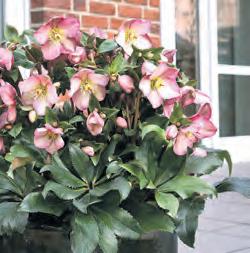
Commonly named ‘Christmas Roses’ these beautiful plants are actually closely related to the Buttercup family. These hardy perennials are a fantastic way to carry the change of seasonal colours through the colder months with a vast diversity of flower colours.
Hellebores are the perfect plant for any level of gardener as they are very easy to care for and are suited to borders, containers and terraces. They like to grow in rich, well-drained soil and prefer a semi shaded spot such as beneath an already established tree. The newest HGC variety ‘Ice N’ Roses’ (Helleborus x glandorfensis and Helleborus x iburgensis) is a particularly strong bloomer, producing their magnificent flowers tirelessly from late autumn well into April.
In addition to outdoor planting for many gardeners and florists, the white blooms of the Christmas Rose are a must in any floral Christmas decoration. For a stunning display, pot any small shrubbing variety into a decorative bowl or vase with some soil, cover with a layer of moss and add some decorative greenery or winter berries.
For more information and to see a wide range of hellebores visit Bernaville Nurseries, just past Cowley Bridge, Exeter.
www.bernaville.co.uk Tel: 01392 851326
2ND
Brixham Horticultural Society
MONTHLY MEETING
Details on 01803 842121
3RD
Plympton Gardeners Association
‘LUKESLAND GARDENS’ - LORNA HOWELL Details on 01752 336057
South Devon Alpine Garden Society
‘OREGON MATTERS, A PLANTSMAN’S VIRTUAL TOUR’ - JULIAN SUTTON Details on 07940 372954
Teignmouth Gardening Club, Bitton House
‘KNIGHTSHAYES GARDENS’ - JESS EVANS Details on 01626 879576
9TH
Ogwell Garden Society
Rosemoor lighting spectacular

November sees the start of the fabulous illuminations at RHS Garden Rosemooran unmissable after dark spectacle of lights at the popular Devon venue .The gardens will be in breath-taking beauty and visitors can follow the longest ‘Glow’ trail yet, with spectacular new light displays. New for this year, is an enchanting galaxy of giant stars on the Stream Field, a tunnel of lights along the long borders, and the orchard shelter all aglow. There the added attraction of such entertainment as craft fairs, choirs and a spectacular fire show night. Glow runs from Thursday, 17th November until 30th December from 4.40pm to 8.30pm. Tickets must be booked in advance. For more detail on prices visit www.rhs.org.uk/gardens/rosemoor/whats-on/rosemoor-glow RHS Garden Rosemoor, Great Torrington, Devon EX38 8PH
You can learn about your own garden’s soil care and sustainability and create a new layout and planting plan, with Kew Gardens and Schumacher College’s former head gardener, Jane Gleeson at a five day course at Dartington Hall. Sessions will include illustrated lectures and hands-on workshops to design your own garden. The tutor’s approach is to act as a guide, showing you the mechanics of garden design and giving you the confidence to exploit the possibilities available Residential and non-residential rates are available for the course from 14th to 18th November.
Dartington Hall, Dartington, Totnes, Devon, TQ9 6EL
‘FOOD FOR FREE’ - BECCA FLINTHAM Details on 01626 364543
16TH
Colton & Strict Garden Society
‘BULBS AND THEIR SELECTION’ - MICKY LITTLE, AVON BULBS Details on 01297 552362
17TH
Otterton Garden Club
‘CREATING A WILDLIFE GARDEN’ - DR GAVIN HAIG www.ottertongardenclub.com.uk
West Down Gardening Club ‘FOR THE LOVE OF BAMBOO’ Details on 01271 865554
Torquay and District Gardening Club
AGM WITH GARDENERS QUESTION TIME Email: nickibaker222@gmail.com
Budleigh Salterton Garden Club
‘A DREAM OF WINTER’ - JULIAN SUTTON Details on 01395 445840

Exmouth Garden Club
MONTHLY MEETING Details on 01395 223848
If your gardening club or association is back in full swing after the restrictions of the past couple of years be sure to let Country Gardener know. Send your club meetings and details to timeoff@countrygardener.co.uk

Whilst watching the leaves of a tree turn from a luscious green to a golden yellow and rich red can be extremely calming, what isn’t quite as therapeutic is the inevitable clean-up that follows once the leaves fall on the ground.
The first thing to remember is to never bag dead leaves. The main reason for this is that they will start to rot inside the bag and create an unpleasant smell. Bagging also makes it more difficult to use them as mulch in your garden, so you should always spread them out on your lawn or garden rather than bagging them up.
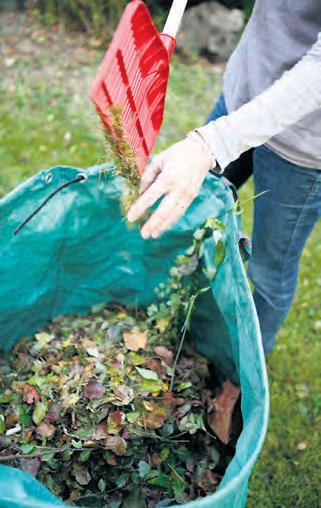
It’s also worth knowing the best time to collect leaves; this is when they’ve been raked up into piles and allowed to dry out a bit. Just make sure they're not too wet when you collect them — otherwise, they won't break down very well in the compost pile.

However, there are many ways you can put your leaves to good use in the garden.
Every week, you should aim to mow over your dead leaves. The blades will chop up the leaves and distribute them throughout your lawn as mulch. This is especially good if you're starting to notice moss growing on your lawn, as mulching will help prevent moss from taking over.

However, mowing over dead leaves is also beneficial for your plants! Over time, the leaf particles will be broken down into nutrients, which help your plants build resilience by developing more robust root systems.
If you have a lot of dead leaves, this is the perfect excuse to create a compost pile. You can make compost with leaves alone or combine them with other organic materials like grass clippings and kitchen scraps. To create compost, simply pile up the leaves in a corner of your backyard and leave them there. Eventually, they will break down into rich soil that can be used as fertiliser for your plants.
Then let the compost sit all winter, turning the pile occasionally to aerate it. If the compost pile starts to appear dry, you just need to add water from your garden hose, whilst turning with a pitchfork. By the time spring rolls around, you should have some nice compost to mix into your garden soil.
If composting sounds like too much work, then you should instead make leaf mould. All you need to do is rake the leaves into a big pile in the corner of your garden. After a year, the leaves should have disintegrated into a dark, sweet-smelling, soil conditioner that is high in calcium and magnesium. Combining this with the fact that it retains water easily, it’s exceptional for potting soils as well as vegetable and flower patches.
Mulch refers to fertilising items placed around plants to help keep the soil moist and retain moisture during dry spells. In addition, mulch helps suppress weeds by blocking sunlight from reaching their roots.
Dead leaves make excellent mulch because they are easy to collect, last longer than other types of mulch (such as hay or newspaper), and do not need to be replaced as often as other types of mulch such as pine needles or bark nuggets.
They do, however, need to be shredded before being used to mulch.
If you have a shed or other small structure in your yard, you can use dead leaves as insulation. Simply pile them up inside the structure and then cover them with a layer of plastic sheeting. The plastic will keep the moisture locked in and protect the leaves from being blown away by strong winds.
As well as insulating your shed, dead leaves can help insulate root vegetables stored in the ground, such as carrots, kale, and leeks. Simply cover them with the dead leaves and they should harvest throughout autumn and winter.
7. Transform the dead leaves into beautiful home décor
Dead leaves can be used as a unique and beautiful decorative element in your home.
If you have some hanging plants or planters, try placing some long strands of dead leaves around them for an interesting effect. You can also create an autumnal display by putting a few different types of dead leaves together on the table or shelves in your living room or kitchen. It's simple but effective!
If you want to create something more elaborate, try placing some dried flowers inside a large bowl filled with brown, orange, and yellow leaves that are all about the same size. That way, no matter what angle you look at it from, it will look good!
Even in the mildest of winter food can be scarce for wildlife. So it’s time for gardeners to give a little thought to how they can help feed and provide conditions to help .
Leave undisturbed wild areas in your garden this winter –piles of leaves or brushwood can make the perfect nest in which animals can hide, rest and hibernate. By leaving the task of tidying your garden borders and shrubs until early spring, shelter can be provided for insects throughout winter.
Avoid pruning berry or fruit-bearing bushes or trees in your garden or on your balcony, as these provide indispensable food for birds over the next few months.
Allow leaves, twigs and sticks to pile up under hedges or in borders. This can provide a cosy home for hedgehogs and dormice to hibernate. The leaves will also shelter insects – which will become food for those insects as the leaves decompose. These insects will in turn be food for birds who will feast by picking at the leaves. On a balcony, do leave a corner to gather any leaves or dust, to provide insects with a shelter.
The winter months are especially tough for animals that don’t hibernate, such as birds, squirrels, badgers and foxes. They must keep their body temperature up by eating sufficient food, but it is scarce at this time of year. You can be their lifeline by making or buying them food. Fat balls, sunflower seeds and (unsalted) peanuts are appreciated by many birds. You can put these up in a tree, or in a standalone birdfeeder if you want to stop the squirrels from getting there first. Birdfeeders make great gifts for birdwatchers or general wildlife lovers. If filled with nutritious food, you can be sure they will be used and appreciated!
Squirrels and pigeons may not be welcome guests. Find feeders that they can’t access.
It’s also important to supply wildlife with water, especially in freezing temperatures. A plant saucer with a few differently-sized stones in it will allow a variety of birds to bathe. If you place the saucer at ground level, many other animals will also be able to drink from it.
If you have a pond, and the surface is frozen, you may want to melt or break some of the ice to allow animals to drink from it. Melt the ice by placing a hot saucepan on the surface, or gently poking a few holes. Avoid breaking the ice with any force, or by pouring boiling water in, as this could harm any fish, frogs or newts living inside.
Ensure you clean birdfeeders and saucers before refilling them, to avoid spreading diseases.
If you have a bit more time, you can provide wildlife with a more substantial shelter.
Making bird boxes can be a fun project over winter’s dark weekends and breaks.
Birds will take shelter in boxes on colder nights, and if they get familiar with the box now, they may choose to nest in the spring. Depending on what bird the box is made for, you can put these up in trees, under your roof, or against a wall, making their use possible for people in flats.
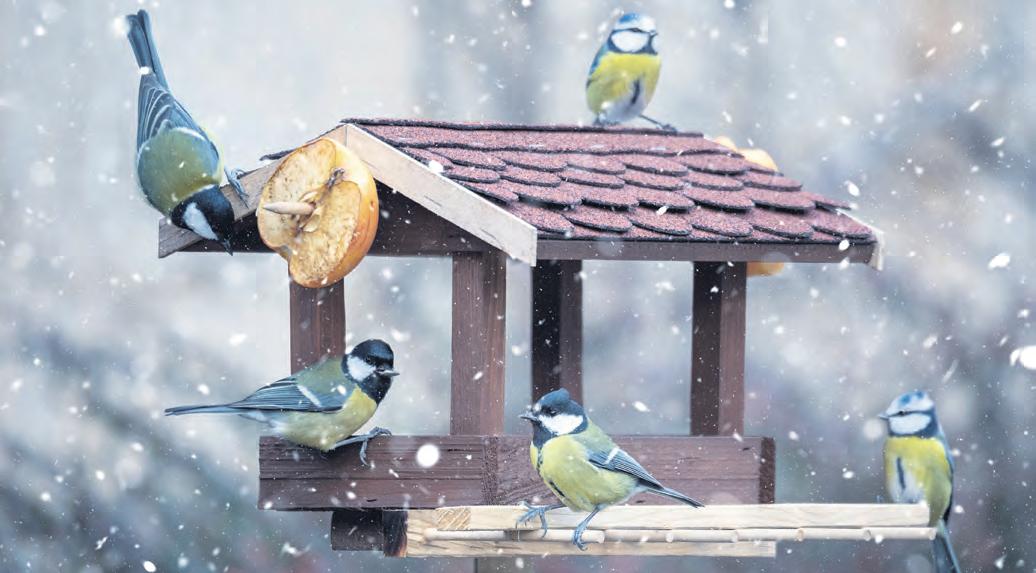
As with bird feeders, it’s good practice to wash nest boxes every so often – but only when you’re certain that you don’t have any tenants, as you don’t want to disturb them!
Nearly half of all hedgehogs die during their first winter. Many starve, while those born in late-summer are often too small to hibernate, and so are unable to survive the
cold weather. In mild winters, hedgehogs are prone to waking up, having been tricked into believing it is spring. They waste valuable fat reserves looking for food.
Provide shelter by making a leaf pile, or making a hedgehog house. Leave a dish of water and dog or cat food to help boost their fat reserves, until it's no longer taken (usually mid- to late-autumn when they enter hibernation). If you find a baby hedgehog, keep it warm in a tall-sided box with a hot water bottle on the bottom, covered with a thick towel. Feed with cat or dog food and water and visit britishhedgehogs.org.uk for advice.
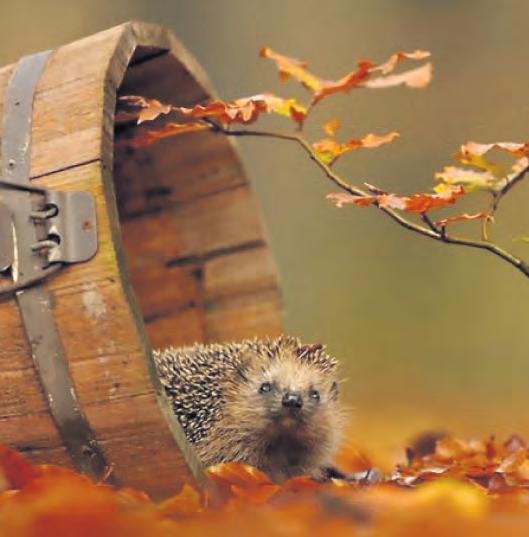
Before lighting bonfires, check wood or leaf piles carefully for wild animals such as hedgehogs, frogs and mice, who like to hibernate in these cosy spots. If you find wild animals in hibernation, be sure to leave them be.
Badgers don't hibernate, but they do sleep through most of the severe weather. They have a tough time finding their favourite food of earthworms when the ground is frozen. They'd welcome nibbles such as lightly cooked meats, cheese, peanuts and fruit.
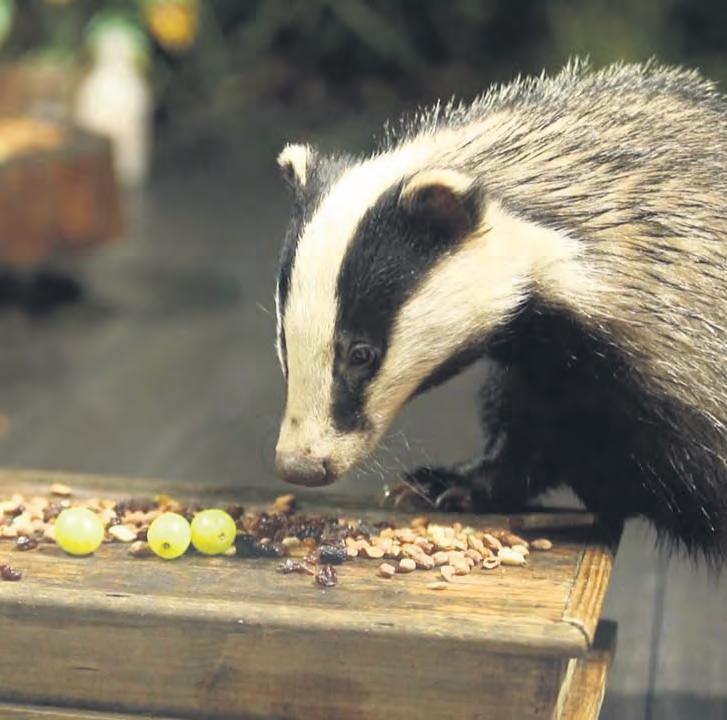
Insects readily hibernate in gardens. Bumblebees dig holes in the ground or rest in leaf litter, butterflies sleep in garages, sheds and between folds of curtains. Wasps, ladybirds and lacewings shelter under loose bark on logs and in cracks in door and window frames.
Recreate the nooks and crannies insects hibernate in by tying up bamboo and sunflower stems, and leave them in a dry spot in the garden. Leave areas of the garden untouched over winter and let areas of long grass remain unmown, so insects such as green shield bugs can shelter here.


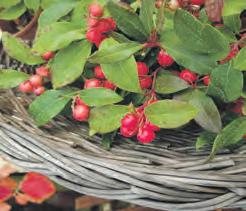

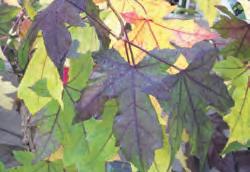

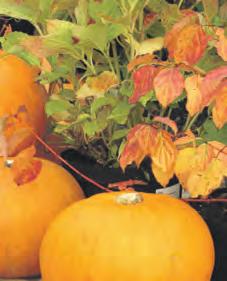


Dedicated one to one
our team of Nepalese
Tel: 01252 282110
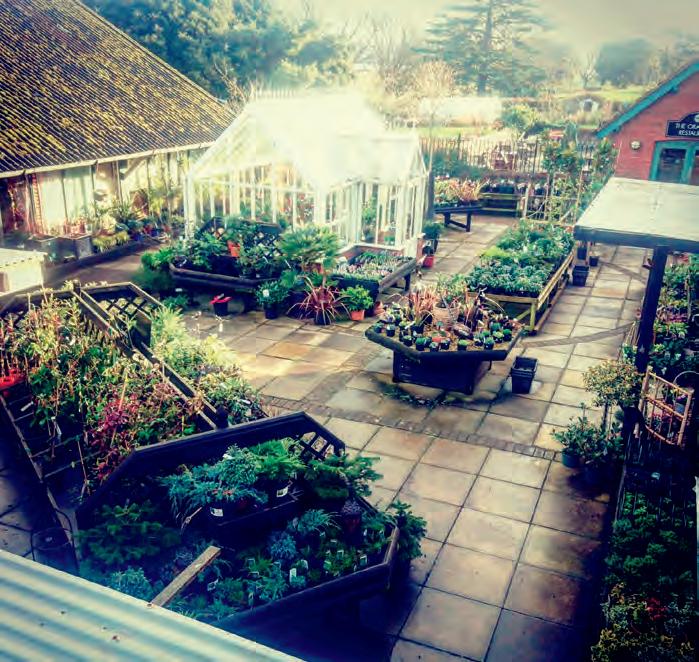

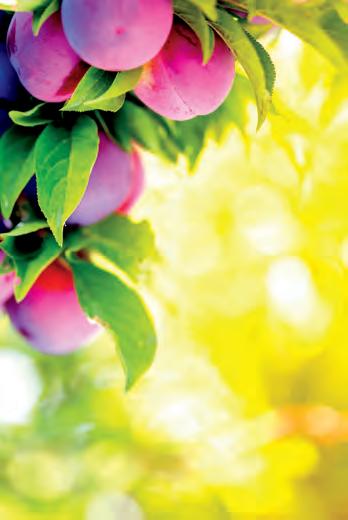
Email: care@poseidon-gp.com Website: www.poseidoncare.co.uk

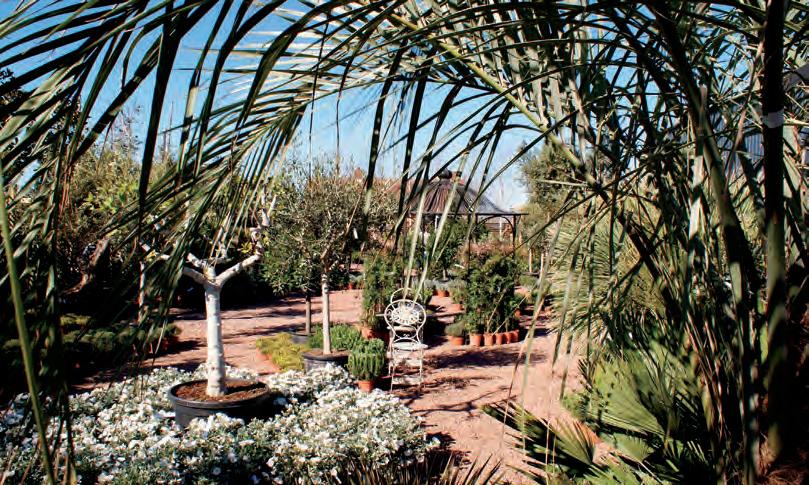


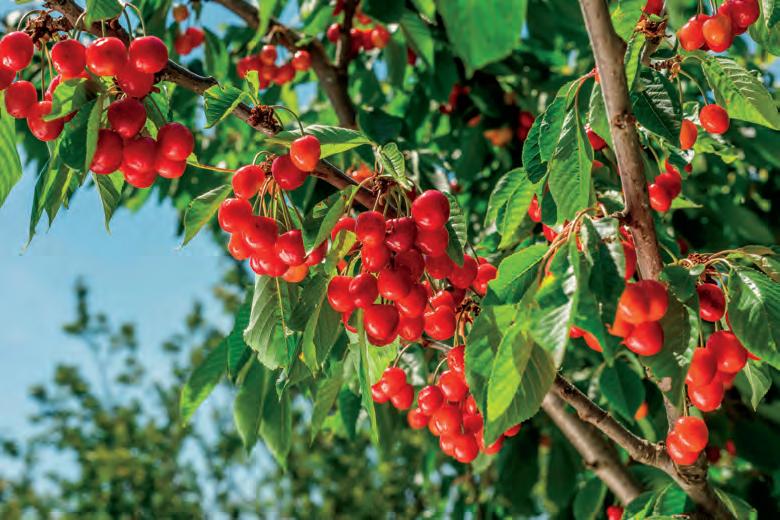




More and more scientific studies find there’s a real benefit from having more houseplants in your home to care for.
It so happens that plants with their fantastic green foliage make people happy. Research has shown plants in the home can reduce tension in people by almost 40 per cent, because they remind us of the outdoors, nature, and a slower pace of life, which is instantly calming.
Surrounding yourself with plants indoors helps to trigger the same chemical response in our brain on a smaller scale, releasing serotonin – also known as 'the happy hormone' – which lifts our mood in a completely natural way.
Plants generate happiness and improve people’s moods. It’s a fact being around foliage triggers responses that bounce through billions of neural pathways in the brain to inevitably inform us that, yes, we’re feeling a bit better.

Simply take a walk around a park and notice how plant nature soothes and relaxes our human nature.
Indoor plants do the same thing.
Whether it’s a lovely palm flowing up from a container or a wall filled with living plants, being surrounding by them makes life seem better.
In a study conducted during pandemic stay-at-home orders, participants who had indoor plants experienced significantly fewer symptoms of depression and anxiety than those who did not. Being surrounded by houseplants led to feelings of ‘being away’ from social or physical demands.
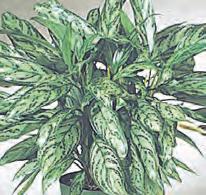
A significant amount of scientific evidence suggests that being around greenery can stave off stress, elevate mood and improve cognitive function, among other things.
Plants placed in hospital recovery rooms as well as views of beautiful gardens help patients heal faster. Plants in offices have a lower rate of employees being out sick. The effects of beautifying the indoor environment with plants are soothing and contribute to well-being and comfort. Indoor air quality also is much better due to plant's ability to pull in stale air and breath out fresh oxygen.
Various other health benefits are:
• Lowers blood pressure
• Reduces stress
• Boosts immune system
• Creates a positive mood
• Improves sleep
So, as we head into the darker and colder days of winter it’s perhaps time to boost the number of indoor houseplants which adorn your home.

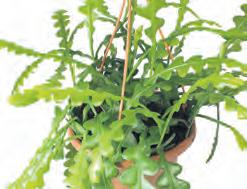

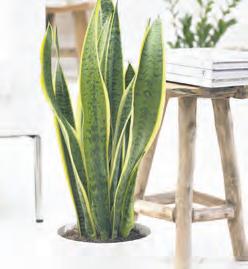
However, the mining of peat can release that carbon into the earth’s atmosphere. Peatlands are also home to rare habitats, with the harvesting of peatlands affecting these native habitats. Forestry England have pointed out that around 80 per cent of peatland habitats in the UK are either lost or damaged.
Against such a backdrop, the UK government has taken steps to ban the sale of peat in horticulture. At the same time, horticulturalists, environmental organisations, and researchers have looked towards alternatives such as coir. The use of coir in horticulture, however, is not completely new, as it was used in horticulture before peat gained popularity in the 1950s.
Unlike peat, coir is an eco-friendly and renewable resource, manufactured with minimal harm on the environment. A waste product of the coconut industry, coir products are made with the natural and organic raw material extracted from the husk of the coconut. At CoirProducts.co.uk (Salike Limited), all their products are ethically produced and sourced. They do not use unnecessary chemicals in the production of the products. Coir growing media, such as coir potting mix, coircoins for sowing, and growbags, are transported in light, dry, compressed forms, with the compressed coir expanding when water is added, which makes these products efficient in transportation and use. They have also taken steps to offset the carbon footprint in transporting goods to the UK, following UNFCCC processes.
•
•
•
•
•
Coir is an ideal replacement for peat, with its ability to retain water and moisture and low nutrient content, with the key advantage of coir being that its production has minimal harm on the environment in contrast to the mining and use of peat. Coir also has excellent drainage. The use of coir also helps enhance the soil, as coir is biodegradable.
There are also a wide range of coir-based products. Products such as CoirProducts. co.uk coir pots are beneficial for plants and a great alternative to plastic pots as well. Coir pots allow plant roots to grow through the pot, which means plants can be relocated on the ground with the pot itself without them having to grow through any transplanting shock (while the pot degrades into the soil over time). In addition, CoirProducts.co.uk signature products such as coircoins are unique in the market, coming complete with a biodegradable cover, making them completely eco-friendly. Coir has also been popularly used in hydroponic growing. With its many benefits and its eco-friendly nature, coir is safe for people and the environment.
Website/shop: www.coirproducts.co.uk/shop Email: hello@coirproducts.co.uk
The extraction of peat for horticulture is threatening the earth’s biodiversity. Peat bogs contain almost a third of the world’s carbon and are vital in fighting climate change.
It’s now getting a lot colder and there’s less daylight hours. But don’t put your garden to bed for the winter just yet! You can still pot up some colourful winter containers, start planning next year’s garden and of course, don’t forget to feed your garden birds!
There’s still some colour to be found among leaves and berries. Winterflowering shrubs such as mahonia media hybrids, winter honeysuckle and viburnum bodnantense will bring gorgeous fragrance to the short days.
Try and spend a little time tidying up your borders – you’ll be pleased you did when spring comes round. This is of course a great time of year to plant shrubs.
Protect tender plants such as phormiums, tree ferns and cordylines in case frost should strike. It may be easiest to move large containers into a sheltered corner and cover them altogether with horticultural fleece rather than covering each plant individually.

The secret to avoiding stored crops, such as onions, rotting before you use them is to empty out the store and check over the veg every couple of weeks. Look the veg over and gently press it to identify any that have started to rot and need to be used soon. Only put firm veg back in the store.


Bulbs should preferably be planted earlier in autumn, but there is still time this November for tulips, daffodils and crocuses. These bulbs can be planted through to the end of the month if the weather is mild before the soil loses the heat from the summer months.
You can always plant bulbs in pots indoors to add some spring colour to your home, just make sure you choose indoor cultivating bubs.
Autumn bedding plants such as pansies, violas and wallflowers can still be planted if you are experiencing mild weather. Make sure you plant winter bedding plants on a sunny day, in rich, moist soil. Adding grit is especially important for soil drainage in case you experience frequent showers this winter.
Traditionally, you should plant tulip bulbs in November. It’s sometimes said that this reduces the chance of tulip fire, but unfortunately it probably won’t have any affect.
Tulip fire usually spreads in the spring and overwinters on bulbs left in the soil. The cold weather has no effect on it. If you have tulip fire remove the bulbs and do not plant in that area for several years. New bulbs will not be infected so the real reason gardeners’ plant in autumn is probably because the border still looks good until the first frost, so why wreck it planting bulbs?
Look for bulbs that have intact skins and don’t show signs of mould. Tulips should be planted three times the depth of the bulb.
4November is the perfect month for treating yourself to a new tree in the garden. There’s something very special about getting a tree in the ground at this time of the year with all the expectation of how it will look and grow ahead of you.
For your chosen tree to develop into a fine specimen, it should be well-branched with one, straight leading shoot and no crossing branches.
Choose a dry, cool day for planting but if the soil’s sticky enough to cling to your boots, it’s too wet for planting. Dig a hole that’s at least twice as wide and also deeper than the roots of your tree and fork over the base and sides to allow roots to spread easily.

To plant, remove the pot and put the tree in the hole next to a stake, which should be on the leeward side to prevent wind rock and movement of the roots. Check the depth – a soil stain on the trunk indicates the ideal depth. Then fill the gaps with soil, which has been enriched with organic matter, pressing it down onto the roots to make sure that it is stable and water in.
Finally, wrap the trunk with a tree guard to prevent rabbits from nibbling the bark.
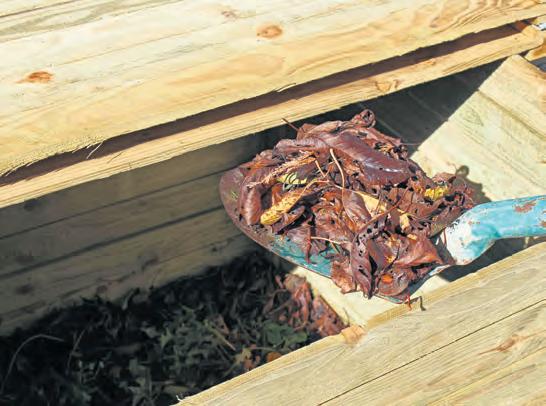
Turn heaps of compost made since late summer to speed breakdown and improve quality. It’s hard work but makes a worthwhile difference as it speeds up decomposition. It only needs to be done once and is a way of introducing oxygen to the heap. This feeds the bacteria, which promotes further decomposition. It’s also a good opportunity to break up any lumps you find and mix the ingredients. The easiest way to do it is to dig out the whole heap with a fork and move it into an empty neighbouring bin.
Sweet peas can be sown outside but they do need some winter protection either under cloches or in a cold greenhouse.
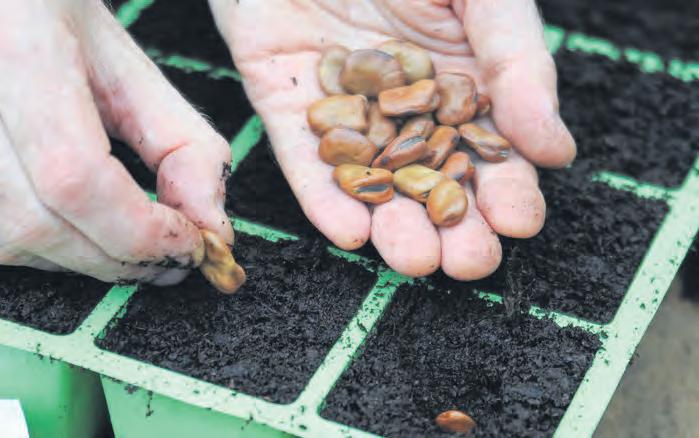
November is the perfect time to start sowing sweet peas for next year – be sure they spend the winter under cover.
Sow broad beans in deep module trays, with the aim of seedlings being about 5cm high by the new year. This small size makes them more weather hardy than larger plants. The reason for the deep module tray is that broad beans quickly put out a long root. Sow in a greenhouse until midNovember and then the plants can go out before or even after Christmas. Sowing them in autumn rather than February means you should have an earlier crop. If the winter is very hard and the autumn-sown plants fail, you can always sow more in February. Remember not to sow too many seeds, as broad beans plants are multi stemmed and give lots of pods.
As you clear summer crops on the veg patch, increase the bed’s fertility for veg by mulching with organic matter, such as garden compost or spent mushroom compost. Apply a 5cm-deep layer and leave the worms to drag it into the soil.
Garlic likes a period of cold so November is a good time to plant it. Put individual cloves 15cm apart in rows that are 30cm apart. Rust has been a problem in recent years so plant in a cold greenhouse or under a cloche to help avoid it.
Remove dead or weak growth and any crossing branches. Shorten this year’s growth on main branches by a third, to a bud facing the direction you want it to grow in. Cut back side-shoots to five or six buds

As long as the soil isn’t frozen or waterlogged, this is the time of year for planting bare root trees. These types of plants are one or two-year-old ‘whips’ that look like long twigs but will soon grow and become robust, quickly-maturing trees.
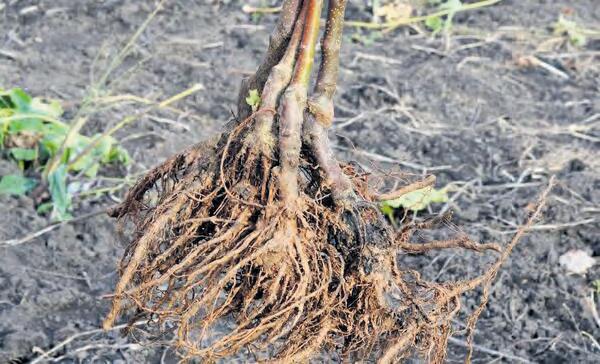
They are sold, as their name suggests, with bare roots, ie. not in containers.
It is an economical way of buying stock, especially if you need to purchase in bulk for planting a hedge or orchard, and the varieties on offer are generally wider than buying container plants.
Try to plant them as soon as they arrive. Otherwise, give them a good soak in a bucket of water then roughly plant in a corner of the garden until you’re ready to put them in properly.
These should now be kept indoors or under glass in a light frost free place. It is important to continue feeding and watering as necessary using winter citrus feed, only watering when the soil is dry. How often this is will depend on where the plants are being over wintered. Pick up and dispose of any fallen leaves.
Grease bands and tree barrier glues (horticultural grease) are a pesticide-free method for reducing the numbers of winter moth caterpillars on fruit trees in the spring. They stop and kill the wingless females from climbing up tree trunks and laying eggs. If a fruit tree has problems with severe defoliation or reduction of fruit crop by winter moth or a related species, this can be minimised in subsequent years using grease bands. Winter moth caterpillars can feed on developing fruit buds of fruit trees such as apple, plum, pear and cherry reducing the amount of fruit produced though where possible we do recommend tolerating their presence. On ornamental trees the damage should be tolerated as it will not affect the long-term health of the plant. The caterpillars are an important part of the biodiversity trees support including as a food source for nesting birds in the spring.
Remember sticky barriers give no protection against codling moth (the cause of maggoty apples), plum moth (the cause of maggoty plums) or other types of caterpillars. Those moths have winged females that are active in midsummer.
Grease bands and tree barrier glues should be placed on trunks and tree stakes about 18 inches above soil level in late October, before the adult moths begin to emerge in November. Moth activity declines after January, but some species with wingless females are active until April.

It’s a busy time of year for tidying up, so make the job easier by sharpening your secateurs.
Begin by cleaning off any hardened sap with wire wool.
Then, use a fine-grade sharpening stone (alternatively, use a sharpening device), hold the secateurs firmly in your hand and sharpen both edges of the cutting blade on anvil secateurs, and only the outer edges of the blades on bypass secateurs.
If you don’t fancy doing it yourself or you’re experiencing other problems with the secateurs, check first as some manufacturers offer servicing.
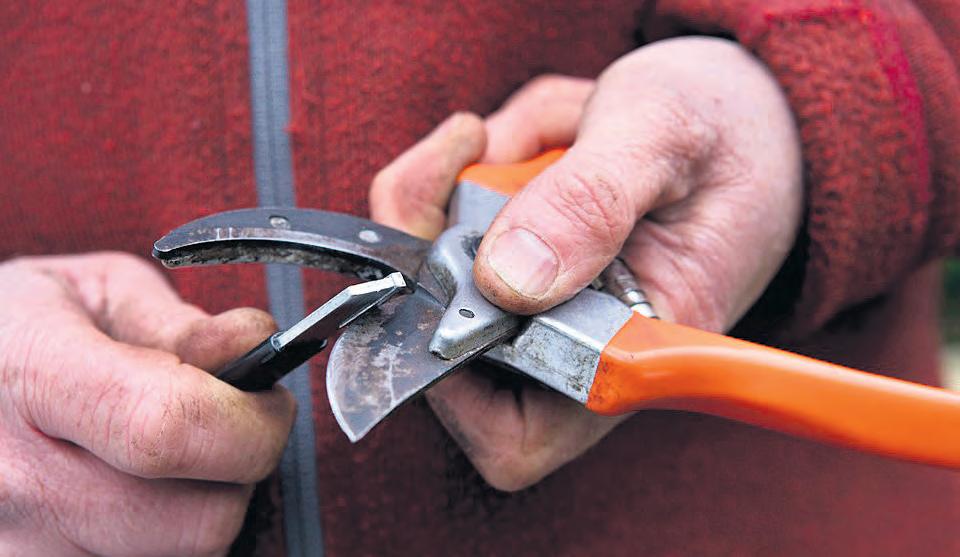
Put prepared ‘Paperwhite’ daffodils – which means they’ve been specially treated to flower quickly –in a pot. Keep indoors and they should be flowering for Christmas.
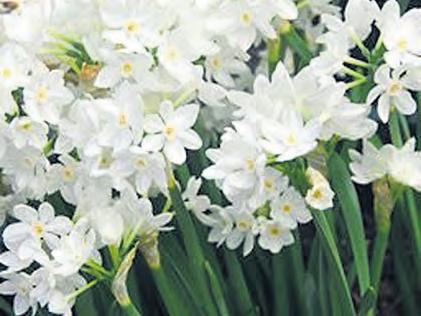
If you’d like to share your views, tips ideas or comments with our readers then write to us at Country Gardener, Mount House, Halse, Taunton, Somerset TA4 3AD or email editorial@countrygardener.co.uk
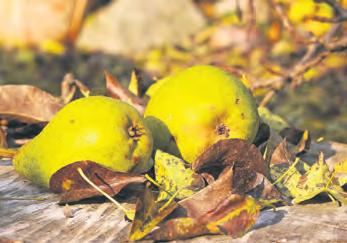
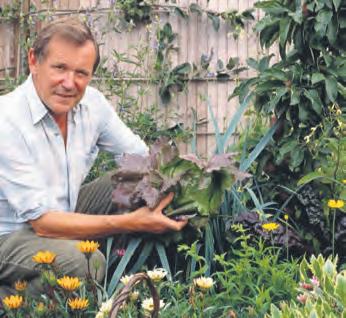
Can I ask anybody who is about to plant hedging to consider who this might affect? Shrubs tend to grow not only upwards but both sides as well. This means the top and your side need trimming but the one not visible which faces your neighbour. It is not their responsibility to cut unwanted greenery overhanging their garden and having to dispose of cuttings. There is also the encroaching foliage on public walkways that makes it difficult to walk on pavements.
Pam Sharrock by email
Several friends on the allotment have had a problem this autumn of pears beginning to form and then quite dramatically dropping off. We’ve investigated this as it has been quite a problem. The answer seems to be that the fruit aborts due to dryness in the roots so we suspect that all over the allotment the dry summer meant the trees were struggling when they formed. So I think we have all had a lesson to learn, mulch and in dry spells, water well!
David Haskins PlymouthWhen I took my young wheelchair- bound daughter to the local garden centre to buy plants for her small garden we noticed there was book sale based I think on donated books for charity. We found "Gardeners’ World Practical Gardening Course" by Geoff Hamilton. We paid the grand sum of £1 for it. The book has been an inspiration to us ever since. It's odd how such a lucky purchase can change things. My daughter is very keen on learning, planning and selecting plants and now if she wants to know something I am told ‘Get Geoff out, he’ll know’. This lovely man may not be with us any more but his influence lives on.
Mary Potter PetersfieldI had a mystery in my garden last week. A fish was in my water butthappily swimming around but how in heaven’s sake did it get there?
I asked around and the best of several suggestions is that a bird landed at the edge of the nearby pond, picked up fish eggs on its legs then landed on the guttering. The egg then gets washed into the water butt, eventually hatched and hey presto. Is that sheer fantasy or a miracle of nature?
Phil Knight DorchesterNeeding some pots to fill the bulbs dug out of the garden we recently went to a local garden centre to buy some new ones. I then recalled the local scheme to get them recycled. The garden centre were happy to supply as many as we needed in return for a charity in donation. Perhaps this is not highlighted enough.
Alan Creswell BathOur allotment group had a talk the other week on vegan gardening which was the best attended of any of this year’s talks. I can only think that from talking to allotment holders this is a subject which is beginning to capture the imagination of gardeners who want more information so they can decide whether it is for them or not. Taking the extra step of avoiding animal manure and bonemeal seems a very easy one to take on this journey. Good alternatives such as seaweed are readily available. Luckily on our plot we seem to have plenty of hedgehog visitors who keep the slugs at bay.
As society moves to a more plant-based diet it seems to make a lot of sense to me that we keep pace with greener options in our gardens as well.
Piers Davies ExeterI don’t pretend for a minute to be an expert but I just don’t see how the no-dig method works in a garden. Surely to start off a no dig system you must dig the soil and remove the weeds. If you just put a layer of mulch on the weeds surely they will grow through and make the problem worse. Also digging out the weeds to start with must help the depth of top soil which must help to give better results. My dad was a great gardener and he always believed that digging the garden over brought air into compacted soil and then when you added organic matter you had perfect growing conditions.
Cory Patterson Wells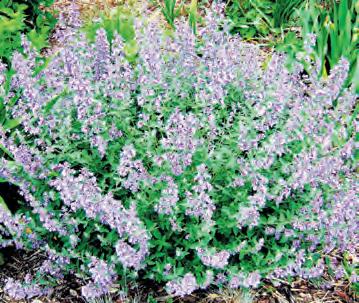
I read the other day about a list of which plants are best for bees in the garden. My top two are blue hardy geraniums, particularly ‘Johnson’s Blue’. But the outright winner for me is good old catmint which we have in the front of the border and this summer, and it has been covered with bees month after month.
Annie Batley Minehead
It is with some sadness that after a few years I am going to abandon growing tomatoes outside. I don’t have a greenhouse or a cloche so growing them in a sheltered position on a south facing wall is the best option I have. For every year I have tried, tomato blight has eventually struck. This time later than normal but with greater speed. Once it gains hold the blight spreads with frightening speed and I went from looking at a good crop waiting to ripen to a discoloured rotting mess in a few days. I have tried most things. I have become meticulous in terms of being clean and tidy around them. Blight will still arrive via air currents or perhaps rain splash which I think is perhaps the real reason. My husband has urged me to give it one more go with a blight resistant variety, but I am not sure if they really keep it away. I hope your readers haven’t had this problem Tomatoes are a joy to grow when all goes well but I am very dispirited.
Jenny Watson via email

















Thousands of bare root trees bought over the coming weeks will not survive because of a lack of understanding on how to plant them.
Research by RHS has found an increasing trend of plant, shrub and tree failures- at great expense to gardeners.
The method for successful planting is straight forward. Once the plants arrive they should be planted as soon as possible, ideally within two to three days maximum to ensure they do not dry out and limit the success of the plant. If you are unable to plant a short-term measure is to store the plants in a cool, dry location. A longer-term alternative is to heel the bare root plants into the ground.
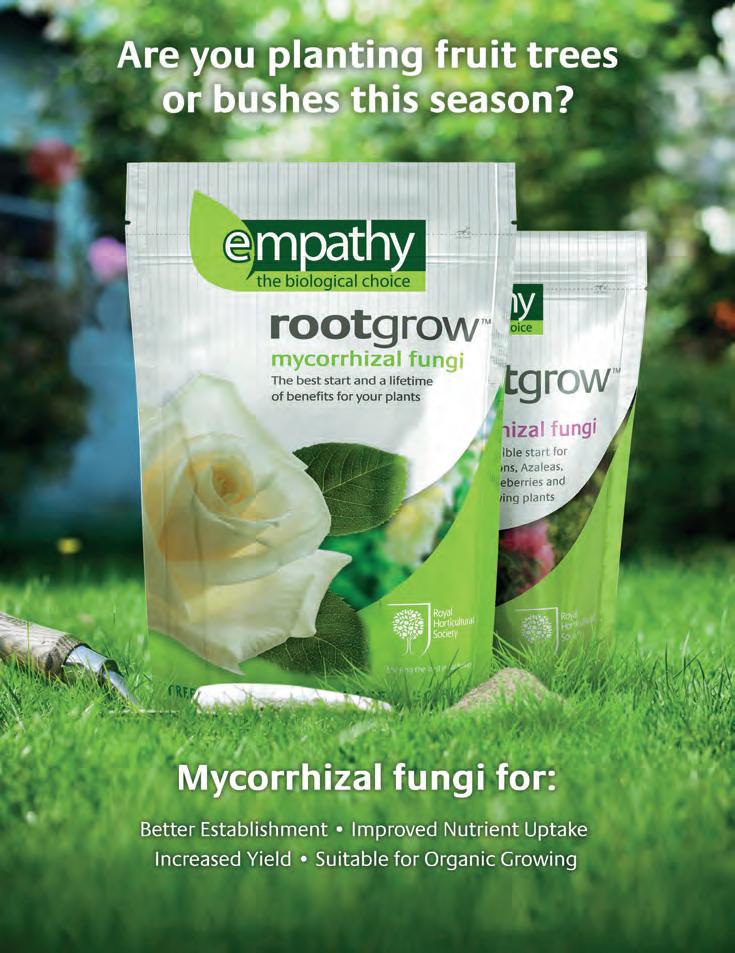
When you are ready to plant, ensure the depth of the hole is deep enough to lightly cover the top of the root system. It is always best to plant in a square hole to aid root establishment.

A soil mark should be visible which shows the depth the plants have been growing at in the fields. Planting any deeper will have an adverse effect on the plant, causing the stem of the plant to rot which could cause the plant to fail.
To ensure the quality of the current soil, add in well-rotted manure or well-rotted garden compost to provide extra nutrients and structure to the soil.
If the soil has poor drainage then adding home compost, sharp sand or coarse grit will ensure a free draining soil and prevent the plant growing in waterlogged conditions.
Once the plants are in the ground, firm the soil around the plant so it acts as a support. This is usually done by lightly treading the ground around the plant. If planting in an exposed location then stake the plant to prevent the plants being blown over.
It is important to keep a four-foot circle around the plant clear of any weeds and vegetation, especially for the first year as these compete for vital nutrients and moisture and can harbour diseases. Mulch around the plants with garden compost, bark chippings or mulch matting and this will also help conserve moisture in the soil.
There is one question which comes out on top when it comes to putting a new hedge inwhat will grow the fastest?
Bamboo is one of the fastest-growing plants in the world, so it can create a lush and exotic privacy screen very quickly. Some varieties of bamboo are invasive, so consider picking a slow-spreading, clumping variety, or planting it in large raised planters to keep it under control.

Bay laurel - valued among the Ancient Greeks, the Bay laurel had strong associations with the god Apollo - and its leaves were even fashioned into wreaths for the victors of an early incarnation of the Olympic Games. Attractive and aromatic, today Laurus nobilis is prized as a fast growing privacy hedge.
One of the most popular choices for privacy hedging, the Cherry laurel is extremely fast growing. Also known as common laurel, this evergreen species thrives in shadier conditions as well as in direct sunlight. Growth wise you can expect about 60cm per year in average conditions, growing up to eight metres.
The privet hedge has become somewhat less popular in recent years. However, if you’re seeking a more formal edge to your landscaping it may well be just what you’re looking for. Its dense growth will ensure privacy and is ideal for shaping. It’s very fast growing and 30 to 60cm per year is to be expected, particularly if you use a plant feed. That means that it will need pruning several times a year to keep it under control and looking its best. Almost as popular as the laurel are conifer hedging and leylandii. This is a fast-growing species that given a little maintenance, will soon give a dense protective screen to lend your garden the privacy you’re seeking. It’s one of the fastest growing hedge plants and can grow up to 90cm in a year so have those pruning shears at the ready!
Now is the time to think about ordering your bare root fruit trees.

At Adam’s Apples nursery in East Devon they grow the largest range of fruit trees in the west country.

This includes over 200 apple varieties, plums, gage, pears, cherries, damson, quince and medlar, all on a range of root stocks to suit your needs. They also sell bare rooted soft fruit plants.
They are passionate and award-winning cider makers too, and grow and sell some of the best traditional cider apple trees from Devon, Cornwall, Somerset and Herefordshire.
All the trees and bushes are sold bare rooted, available from late autumn through to spring.
Bare rooted trees are cheaper to purchase and easier to transport than potted trees and are the quickest way for trees to establish and thrive.
The staff are always happy to offer advice and recommendations for your garden, small holding, farm or community orchard. They deliver trees throughout the UK.
sales@adamsappletrees.co.uk www.adamsappletrees.co.uk
Tel: 07521 648502 Adam’s Apples Nursery, Dulford, Cullompton EX15 2GA
Autumn and winter are the optimal months for planting trees and hedges. Many species of trees can be planted bare-root, most of the natives such as hawthorn, dog rose, field maple, oak, poplars and willow and some more ornamental varieties such as flowering cherries, rowan and crab apple.
Pot grown ornamental trees will do best planted in autumn along with pot grown fruit trees. Bare-root fruit trees can be planted from December/January. They have a wide range of apples, pears, plums and apricots and more unusual varieties such as quince and medlar.

Perrie Hale Nursery is primarily a wholesale nursery but they also sell to members of the public. They welcome visitors but please bear in mind it is a working nursery and there may be tractors moving about and you might need to bring your wellies!
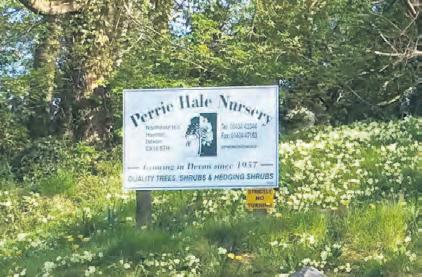

You can download a catalogue or look at what is available on website: www.perriehale.co.uk email: faye@perriehale.co.uk
When
The

it can be tricky to get them established and they can be slow to
fungi at planting time.
root system to the plant enabling the plant to explore
turn leads to better establishment earlier growth and a
Gel as this can be made up as a root dip and is far more economical. rootgrow.co.uk
Easterhill Herbs and Willow in Starcross grow over 30 varieties of willow (Salix) for ornamental and wildlife value, living structures, basketry, and craft.
Colourful, ornamental willows make great statement shrubs and wonderful winter interest in gardens. From greens and yellows to bright reds and purples, black, orange, textured or curly, there are so many attractive variations, many of which can be used for floristry, craft, and basketry.
Robust varieties are excellent for creating willow structures in gardens or community spaces. Vigorous and thicker growing willows make effective windbreaks, fences, and hedges.
Willows are beneficial for wildlife with early spring catkins a source of food for pollinators. Willows can also improve soils, can be used as a rooting hormone, dye plant, and has medicinal properties!
Willows can be planted as stem cuttings or rods in the winter making growing willows very simple.

For willow sales, commissions & willow workshops. reallyusefulplants@outlook.com www.reallyusefulplants.co.uk
We offer special all counties prices when advertising with our features, plus 100 words of free editorial with an advert. Speak to one of our sales people for more details.
We may be approaching the colder darker days of November but there’s no let up with the advice being sought by readers. If you need help or advice then write to us at Country Gardener, Mount House, Halse, Taunton, Somerset TA4 3AD or email editorial@countrygardener.co.uk
Last year’s poinsettia is still green. Is there any way I can make it turn to traditional red?
Poinsettas are rather finicky and produce their flowers and colourful bracts only when triggered by a consistent reduction in the length of the days. So, from now on keep your plant in a room you do not use. Around 5pm every night turn off the light and drape the plant in black cloth or even cover it with a cardboard box to exclude the light. At 8am the next morning remove the plant from the artificial night and place it in the brightest spot you have. Repeat this every day for two months to secure flowering. This isn’t an easy solution, but the rewards will be astounding.

In our school gardens this year we created a pumpkin patch. I went away for two weeks holiday and came back to a pumpkin explosion. The plants were huge with runners going everywhere. How do you control and look after these monster plants? Should we have cut them back or limited the number of pumpkins to one per plant for example? The patch is a great success with the children and we’d like to get it right the next growing season.
Pumpkins will begin to produce long stems which can be trained in a circle around the plant to prevent them spreading too far. There’s no need to limit the fruits unless you are planning to grow giant pumpkins!
You will need to feed and water your pumpkins regularly. When growing pumpkins, a thick mulch of organic matter spread around the plants will help to conserve moisture at the roots. If possible, hoe between the plants regularly to prevent weeds from establishing.
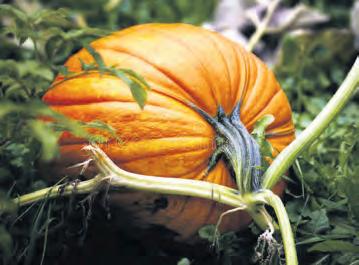
Leave the pumpkins on the plant for as long as possible until the skin has hardened and the fruits start to crack near to the stem. You will need to harvest the pumpkins before the first frosts by cutting each fruit from the stem leaving several inches of the stem attached.
How do I know when a plant is established and will grow successfully? I seem to have a few in my garden which are struggling for ‘take-off’?

After you transplant a plant into your garden, it will take time for the root system to develop and spread into the surrounding soil and for new growth to appear on the plant. This is the time (prior to becoming established) that your plants need more food and water, since their root systems are not able to adequately extract them from the soil. Once the root system is established, you will notice new growth above the soil. You will also notice that you cannot simply yank the plant out of the ground with a little tug. Shrubs can take one to two years to become established. Trees might take up to three years to become established in your garden. There’s no firm rule to knowing they are established but the secret is often seeing new growth on the plant.
I’d like to pot something up, perhaps a perennial, that we can leave at my mother- in-law’s grave, but we only get to visit the churchyard a few times a year; could you recommend something nice but hardy that can deal with a little neglect?

Often it is possible to plant directly in the ground by the headstone, and this would be better as even the toughest plant will still need watering if it is grown in a container. You need to focus on low maintenance perennials with a compact growth habit such as primrose vulgaris, polyanthus ‘most scented mix’ or dianthus ‘gran’s favourite’. these could be under planted with spring bulbs such as narcissus ‘tete-a-tete’ and Russian snowdrops. All of these are resilient and should cope with a bit of neglect.
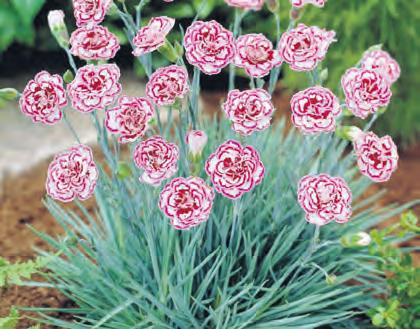
I have a tree peony which I bought two years ago. It does not seem to progress at all. It is still a small pathetic looking plant and has never flowered. I was thinking of replanting it but I would like to know what sort of compost to fill the new hole with.
Tree peony’s are notorious for being slow to flower. They really need to be well established before they start to produce blooms and this can take three years or more. It’s also worth checking that they are growing in suitable conditions and making improvements where necessary. If conditions are unsuitable for the plant, then it may be better to move it, but remember that this will delay establishment further still.
Tree peonies are at their best in sunny positions and won’t do well in shade. They also need shelter from cold drying winds and strong early morning sunlight. Check the soil isn’t too wet as the plant will struggle and eventually rot - tree peonies like moist soil, but it must be well drained.

If you do decide to replant it then you can mix some ordinary multipurpose compost into the soil before you dig your hole. Don’t be tempted to backfill the planting hole with just compost - it needs to be mixed thoroughly with your own garden soil. It’s important that the peony is planted so that the grafted union sits at least four inches below the soil surface- this sounds deep but shallow planting may hinder establishment and delay flowering.
Feed it with a high potash fertiliser during the growing season as they are heavy feeders.
I have some rose bushes in my garden that were left by the previous owner. A couple of them have flowers with very floppy stems - they’re not strong enough to hold up the flowers. Is this just a problem with the varieties - but there are two different ones with this problem, growing near each other - or are they short of minerals or trace elements, which would help them hold their heads up properly?
This is a common problem with roses, particularly the large flowered English roses. The problem is the big puffy flower heads are too heavy for the stems, particularly in wet weather. This is their normal growth habit and tends to improve as the plant matures. You can help prop them up by inserting a few twiggy sticks discreetly around the bush to hold the growth more upright. Insufficient sun can also be a contributing factor to weak spindly growth. It may be worth reviewing the position of these roses and moving them in the autumn. You can encourage stronger growth and thicker stems by pruning them back in winter by no more than a half. They are quite greedy plants however, so an application of slow release fertiliser in spring and autumn will be beneficial.
Every year we have more and more ants in our garden - the lawn has more and more nests. I use ant powder but it doesn’t seem to work. Ants are generally quite beneficial in the garden as they feed on sap sucking aphids and the honeydew that they produce. But I just don’t like so many of them living in my lawn.
There are products on the market from powders to gels that can be used to kill a nest. The gels are often found to be slightly more effective so it might be worth trying one of them during a period of drier weather. You can also buy nematodes that are watered onto the area and these are very effective too. You could try the old-fashioned remedy of pouring boiling water over the nest - this will certainly upset them but also tends to kill the grass. The other option is to find a way to live with them. You can reduce the mess made when mowing by raking over and excavated soil mounds on a dry day prior to mowing. If you can encourage birds into your garden then they will readily dispose of any ants and eggs that are brought to the surface by this process.
I collect tomatoes seeds from tomatoes but when I grow the seed the next year, why are they not the same as the first?
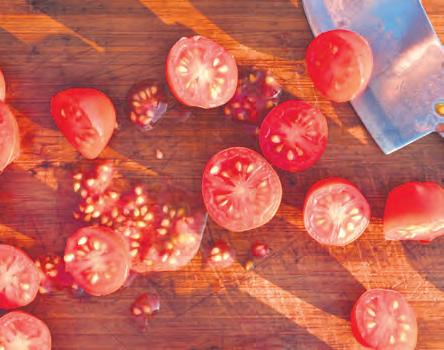
You are probably saving seed from F1 Hybrid varieties, but these will not come ‘true’ in the next generation. These tomato plants are produced from two parent plants both of pure breeding lines, in order to create a hybrid with particular characteristics from those parents. When you grow plants in your garden they are cross pollinated by insects, thereby introducing different genes. In addition, F1 Hybrid will often revert to the type of the more dominant parent line and take on those characteristics.
It can take years to develop an F1 hybrid which is why the seed is so expensive compared to open pollinated variety. You would probably have a bit more luck if you stuck to non-hybrid, open pollinated varietiesmany of the heritage tomatoes fall into this category.
My father always told me adding tea bags to moth orchids helped them to flower. Is this an old wives tale?
Michela Dawson WellsTea leaves contain a range of minerals that are released as they break down. Moth orchids naturally grow on the branches of rainforest trees where they are fed exclusively from the moisture running off rotting leaves. You can see where this is going and certainly adding tea bags may replicate the environment. So, not certainly an old wives tale but something that is somehow based on fact.
Is there an organic weed control for a gravel path?
Annual weeds can be dealt easily with but perennial weeds coming up from extensive root systems are another matter. First, stop more seeds arriving on your path by cutting back nearby seedheads and cutting back weeds before they seed. Some local authorities are now using acetic acid and industrial vinegar and others steam guns which all qualify as being organic. A simpler way is to cover the weeds with a temporary heavy duty matting as approved for outdoor pathways. Fit pieces of this over the problem area for a month and then move on to the next section.
From cacti, aloes and agaves to sedums, sempervivums and echeverias, their botanical connections vary widely. But one characteristic unites them: succulents store water in their leaves, stems or roots.

Whether you’re propagating succulents from leaves or stems, allow several days between the time you take cuttings and planting day. Allow the cuttings to dry. The open wounds should form protective calluses in three to four days.
• Leaf propagation works best for succulents with fleshy leaves, such as jade plants or echeveria and sempervivum rosettes. To root successfully, the leaf must stay whole. Grasp the leaf with your forefinger and thumb and gently rock it back and forth to loosen it. Then carefully detach the leaf, with its base intact, from the mother plant.
• Stem cuttings work well for succulents with distinct stems, such as stacked crassulas and spreading or upright sedums. Use a sharp knife to cut stem tips or take an entire stem for multiple starts. Make each cutting two inches long, with several leaves.
Should you take the runners off raspberry plants and if transplanted do they stay true to parent plant?
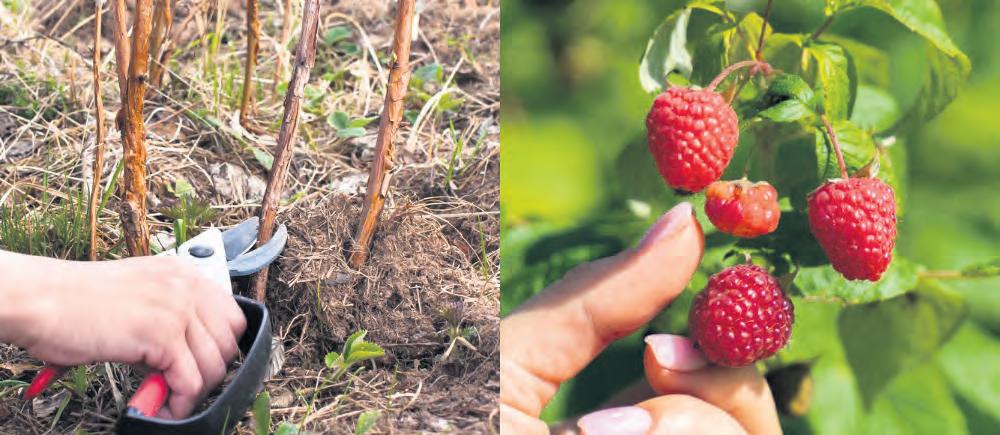 Samantha Green Taunton
Samantha Green Taunton
It’s a good idea to remove suckers to keep the plants with their allotted space. If you would like to use them elsewhere in the garden, or share them with a neighbour, then they can certainly be potted up and they will be true to the parent plant. When you remove the suckers try to dig down a little and get some roots. These can then be potted up at the same depth that they were growing in the ground.
Once your leaves or stem cuttings callus and planting day arrives, follow these simple steps:
• Prepare your planting containers or trays. Use a coarse potting mix designed for cacti and succulents, and dampen it slightly.
• Pour a small amount of rooting hormone on to a tray.

• Moisten the leaf base or the cutting stem, then dip it into the dish of rooting hormone. Cover the leaf base or stem thoroughly.
• Insert leaves or stems carefully so the rooting powder stays in place. Then gently firm the potting mix around the cuttings.
• Don’t water until roots begin to form. Then water well and let the soil dry out before you water again.
• Replant your new succulents from trays to small containers once roots have established.
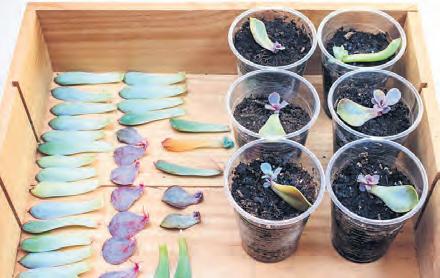
Succulent is a catch-all name for a plant group that includes thousands of species, some closely related and others not related at all.Leaf propagation works better with fleshy leaves

Primary schools throughout the South West have this summer been taking part in ‘The Growing Hope Project’gardening initiative run by childhood bereavement charity, Winston’s Wish, to create a calm and supportive space for bereaved children.

These gardens have been sprouting up across primary schools in the South West of England and provide a place for children who have experienced the death of somebody important. Their purpose is to connect children with others who have had similar bereavement experiences, access support and share understanding with one another.
It remains another example of how gardening and growing plants and flowers can help with therapy and emotional support.
The gardens support children in understanding their change in life circumstances through nurturing and caring for their plants. Emma Tyer, Project Creator and Manager of Growing Hope at Winston’s Wish said, “Observing the changes that plants go through in their own growing life cycle helps children to understand the concept of life and death.”
Two of the children involved in the project at one school shared their thoughts about their experiences of the garden. Billy, age eight, “I like going to the Garden of Hope because it makes me think of my Nan, and I miss the hugs and kisses. I have grown sunflowers for her, and I am going to take them to her grave.” Another pupil who found Growing Hope a place of comfort was Maisie, age 8: “When I have my lunch, I always go to the Garden of Hope to find the lavender as it was her favourite. I talk to her about school, and it makes me feel calm.”
The ‘Growing Hope’ project provides emotional tools and activities to strengthen the understanding of grief and bereavement across school and local community. Growing Hope practitioner Laura Hewetson said: “Through the Growing Hope project, children can realise that they are not alone and that the many emotions we feel when grieving such as sadness, anger, anxiety, guilt, fear, denial, disbelief, and confusion are part of the journey. It's also important to give them a space to feel joyful and happy and remember that being able to laugh is also allowed. Using metaphors from nature, such as the weather and the seasons, to talk about emotions can really help with this."
Alongside the therapeutic benefits of a place to grow plants and reflect on their special people, these gardens
help grow their supportive network by spending time with other children who’ve experienced similar circumstances. The collaborative nature of the project helps children and their parents to better cope with their loss and reduces the experience of isolation that is often associated with being bereaved.
One Somerset schoolteacher who has been involved in the project said children showed an understanding of the problems of grief and how others needed help beyond their years.
“We have always had a gardening project here and growing flowers and allowing other children to take a special role in the work of Winston’s Wish has been so wonderful.”
Pauline Getter, Leader and Co-ordinator of Growing Hope at Wansdyke Primary in Bristol said “We were so proud to have been part of Winston’s Wish Growing Hope project last year. We started the year with ten children and through personal circumstances; the numbers sadly grew to 15.
“Children grieve in a unique way and we give them time in our garden to grieve and share at their own pace. The children themselves changed the name ‘Growing Hope’ to the Garden of Hope reflecting their safe space.
“At Wansdyke Primary, we are blessed with grounds that
allow the children to feel part of nature and this allows them to feel more connected to the surroundings and the rhythms of life. Where the children are encouraged to listen and support each other. Some of the work the children have produced show how they have matured in their grieving process, and they are able to approach schoolwork in a more positive way.
“Futura Academy are also fully supportive of our work with Winston’s Wish and the parents and carers have been so appreciative of this programme, so much so they have provided equipment and plants and join in on our weekend work parties to prepare our grounds for planting.
“The parents come here, out of school hours together with their children. Where the parents may find it difficult to talk about a lost loved one at home, here, they find the common ground of working together has allowed conversations to flow and it has helped parents and carers come to terms with their loss too.”
Thanks to the support of charitable trusts such as DPD Eco Trust and Assura Community Fund, Winston’s Wish are ready to support more schools.
If you’d like to learn more getting involved in Growing Hope or the therapeutic use of gardening, visitwinstonswish.org/growing-hope.

Schools in Devon, Dorset and Somerset are among those at the heart of a moving project to create gardens filled with flowers and plants to help bereaved children with their emotions
The idea of Winston’s Wish took root when clinical psychologist, Julie Stokes, visited the USA and Canada on a Winston Churchill Travelling Fellowship. She was Inspired by the services she saw there, she returned to the UK and set up the project to help bereaved children.
Finding the right sort of Christmas gift can almost be as stressful as Christmas itself. There’s a huge advantage however when it comes to buying something for an enthusiastic gardener.
There are many routes you can go down on your quest for gardening gifts. If the recipient is trying to encourage wildlife into their garden, perhaps a bird feeder or bird bath would be good choices. If they have a vegetable garden, then plant markers, gardening gloves or a lovely watering can might be useful.
Working in the winter garden opens up the possibilities too and our list includes great quality lambswool knitwear and wonderfully warm camel wool socks.
So many people are now fans of the slip on Backdoorshoes they use themselves that they include them as Christmas gifts for others.
Here’s just some ideas for you to look at.
Camel wool socks are made from the wool of the two humped camels which live in the cold, snowy deserts of Asia, where temperatures can drop to minus 40.
In Spring the camels are combed to harvest their moulting winter coats. The wool is then graded and spun into warm, soft, practical garments.
As well as organic pure camel wool socks ethically made in Mongolia there are a variety of other socks, including machine washable camel wool mix and dog wool mix socks (suprisingly soft!) in a range of colours. Prices start at £6.99 + P & P.
These affordably luxurious socks are available online at cozycamels.co.uk

If you are a nature lover, then a great Christmas gift to opt for is WoolOvers’ 100 per-cent lambswool knits.


Lambswool is characteristically softto-the-touch. Perfect for keeping you comfy as you work in the garden and tend to your flower beds.
Getting your hands dirty won’t be a concern. The outer layer of lambswool is naturally protective and prevents dirt from being absorbed. It is also an active fibre that will keep you cosy in the winter and cool when it is too hot. You won’t get sweaty while hard at work in the garden!
Lastly, lambswool is biodegradable and does not contribute to plastic pollution. It is kind to you and the environment.

Tel: 01444 462790 woolovers.com




Largely inspired by gardens and nature, Seasons Green, a small independent shop in the heart of Corfe in Dorset offers plenty of Christmas gifts for those with green fingers.

We love Emma Bridgewater’s ‘Vegetable Garden’ range, as well as her ‘Shed’ String Tin. Or how about an Indoor Watering Can, Gardening Gloves, Paper Pot Maker or Ceramic Bird Feeder - all by Burgon and Ball. But it’s not all practical - there’s a huge range of gifts and art; accessories; jewellery; kids gifts; stationery; craft kits and supplies; decorations; lights and home decor. They offer a personal service, fast delivery or free Click and Collect. They’ll even wrap your gifts beautifully and send them to you or direct to the recipient.
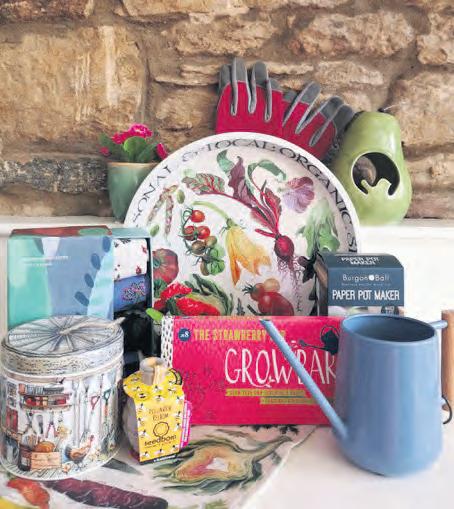
www.seasonsgreen.co.uk or 01929 477228


Keen gardeners will certainly enjoy a Christmas present with a difference with specially packaged coir garden products. You can make it a season of joy with CoirProducts.co.uk specially curated coir bundles for all. Packed with a whole host of natural and peat-free coir, CoirProducts.co.uk coir bundles are one-of-a-kind. CoirProducts.co.uk Grow with Coir Starter Pack, containing 20 coir discs, gives over 20L of coir when expanded, while the CoirProducts.co.uk Indoor Coir Pots for Creepers pack comes complete with coir pots and growpoles for growing creepers. For sowing, CoirProducts.co.uk specially discounted Oh Coir and Let’s Sow with CoirProducts bundles are natural, biodegradable, and peat-free. The Let’s Sow with CoirProducts bundle contains 200 coircoins in four distinct sizes.
CoirProducts.co.uk coircoins are unique with their biodegradable cover, making them the perfect stocking fillers for the eco-conscious gardener. CoirProducts.co.uk products are ethically produced and sourced, with minimal harm on the environment.
Shop: www.coirproducts.co.uk/shop: Email: hello@coirproducts.co.uk

Backdoorshoes are the perfect gift for everyone on your list this year!
The popular manufacturers have introduced more designs this year to their already vast range of waterproof, lightweight garden clogs to include ‘Bees’, ‘Green Camo’ and a slate design. There are sure to be more designs arriving next year

Perfect footwear to slip on/off and nip outdoors to tend to the garden, walk the dog and even put out the bins! Prices start from £32.95 inc free standard delivery. Sizes available from UK 3-14.
As the weather is changing all the time there are also a wide variety of Ultralight Wellies or Chelsea boots to choose from. Footwear for all weather!
Proud to be British designed.
For the full range visit www.backdoorshoes.co.uk or call 01202 232357


It is that time of year when you need to start looking for gift ideas. Look no further, Backdoorshoes have the perfect solution! They are lightweight, waterproof and durable, ideal for slipping off/on when you need to. Mens and Ladies range available online in sizes UK 3-14. We also have a range of Chelsea ‘Jumpy’ Boots and Wellingtons. Footwear for everyone - we’ve covered all of the weather eventualities! To see our full range visit www.backdoorshoes.co.uk or talk to us on 01202 232357
We offer special all counties prices when advertising with our features, plus 100 words of free editorial with an advert. Speak to one of our sales people for more details.
Camel and camel wool mix socks


Shute House on Dorset/Wiltshire border makes the grade to move to an important national register of gardens to be protected

Gardens of major historical importance are protected by being listed like any historical property, and they are on a national register – but there’s an increasing number of private gardens that make the grade as well.
One of them is the garden at Shute House at Donhead St Mary, near Shaftesbury, on the border of Wiltshire and Dorset, a former rectory with a garden that was designed by Sir Geoffrey Jellicoe, one of Britain’s finest landscape architects. He was originally commissioned in 1969 to create a water garden for Lady Anne and Captain Michael Tree; it’s said it was his favourite work and is considered by many to be his best.
The River Nadder rises at the top of the garden and is diverted into canals, waterfalls, rills and pools through a series of atmospheric garden ‘rooms’.
The present owners, John and Suzy Lewis added to the garden’s importance when they in turn commissioned Sir Geoffrey to complete the garden when they arrived at Shute House in 1994. The work on the gardens has continued ever since, but keeping the essence of Jellicoe’s design.

Shute House Garden was added to Historic England’s Register of Parks and Gardens of Special Historic Interest in England in 2020 as a Grade II* park and garden. The garden is open by appointment to groups, and also opened for a special day event for the National Garden Scheme in May.
There is a parterre of box hedges containing six gardens, each with a different theme, a camellia walk with more than 100 varieties, a canal of arum lilies overlooked by Chinese balconies, an amphitheatre of box behind a double bridge swathed in wisteria and ivy, a ‘beastly’ garden full of Arisaemae and Orthiopoga, and the now famous rill that tumbles down musically to the Kashmiri bubble fountains.
What’s the criteria for the listing by Historic England in this Register? It was established in 1983 and now identifies more than 1,600 sites assessed to be of particular significance. It was recognised that historic parks and gardens are a fragile and finite resource that can easily be damaged beyond repair and can even be lost forever.
Whether the sites are in towns or the countryside, Historic England acknowledges that they are important, distinctive, a much cherished part of our collective inheritance, and there’s a duty not only to care for them, but to protect them.
The emphasis of the Register is on designed landscapes rather than on planting or botanical importance. Gardens, grounds and other planned open spaces such as town

squares have made it on the register – most started as the gardens of private homes but public parks and cemeteries also form some of the categories.
Shute House Garden is therefore a special private garden to be included, and reflects the importance of Sir Geoffrey Jellicoe’s work. More gardens may be added to the Register in future and applications can be made to Historic England. Details of the sites can be found on the website at www.historicengland.orguk/listing/what-is-designation/registered-parks-and-gardens Gardens, parks and other green spaces are of historic interest when they are particularly old (early 18th century or before). In general, the older a garden, the more likely it is to be a rare example of its kind, but Shute House shows how a more recently designed garden is equally important.
A garden might illustrate some particular aspect of garden history, perhaps the work of a particular designer such as Geoffrey Jellicoe, or have components remaining from a particular period or which are designed in a particular style.
The garden may have significant historical associations, perhaps with a particular person or event, or have a group value in combination with other buildings or landscape, which together make them of historic interest.
If you think a garden in your area should be added to the Register, there’s plenty of information given on Historic England’s website on how to make an application. Detailed research should be carried out both on the site and in local record offices and libraries. All sorts of records add to the potential success of the application - maps, plans and photographs, prints, drawings and engravings, and documents including accounts, sales particulars, family papers, guidebooks and many more.
It’s a long process but at the end of it a private garden like the one at Shute House could be saved forever.
Sir Geoffrey Jellicoe, one of Britain's finest landscape architectsIf you are looking for things to do in the build up to Christmas then the popularity of illuminated trails in gardens through the south and south west are springing up all over the place this winter. Being an outdoor event, they’re the ideal place to be able to enjoy the sparkle of Christmas and have proved to be hugely popular.
The combination of spectacular hi tech lighting plus music, has meant the trails continue to grow in popularity.
They often include tunnels of fairy lights and themed illumination, flaming torches, lasers, glowing snowflakes and stirring seasonal music are also quite likely to feature. These events were well-suited to Covid regulations two years ago they take place outside in spacious grounds or parkland, as it was relatively easy to socially distance, and they always did involve reserving tickets in advance.
Post Covid their popularity has led to more gardens to invest in often four or five week’s worth of trails.

The popular Sir Harold Hillier Gardens near Romsey in Hampshire has a new ‘Light Up’ theme starting on 24th November, typical of the extra investment being made to offer a pre Christmas attraction for visitors.

Hestercombe Gardens just outside of Taunton stages its own Illuminate event starting from Thursday, 24th November through to Friday, 30th December. On daily from 5pm to 8pm tickets cost £12.50 but for this year the floodlit train through Hestercombe’s gardens is three times the size of last year.
RHS Garden Rosemoor in North Devon has built up a reputation for a spectacular lighting event in its gardens. It launches RHS Glow 2022 on 17th November and runs through to 30th December from 4.40pm to 8.30pm. It will be the longest Glow trail yet with new light displays. Members cost will be £8.95p with non-members £14.95.
The after-dark illuminated trail through the garden at Stourhead the Wiltshire National Trust property returns for its fourth year on selected dates between 25th November - 1st January. You can book now to discover a world-famous landscape in a new light for the festive season. Now firmly positioned as part of the UK’s winter calendar, over a million twinkling lights and seasonal sounds fill the air with festive fun at Stourhead.
Westonbirt Arboretum’s Enchanted Christmas is back! Elves have made their way to Westonbirt, The National Arboretum to decorate for Christmas. But they’re running slightly behind schedule… will the trail be ready for Father Christmas?
From 25th November until 21st December, this well-loved experience will take visitors on a journey through beautiful woodland, transported into a magical world surrounded by colourful twinkling lights. With wondrous light displays to explore and mischievous elves to meet, this is Enchanted Christmas as you’ve never seen it before.
Tickets are available through advance booking only see: Forestryengland.uk/westonbirt/enchanted-christmas
Cornwall in the winter can be a stunning experience. There’s nothing more dramatic than watching a tumultuous sea from a windswept clifftop. The crowds
gone and there’s room to enjoy yourself
Caravan and Touring park in Cornwall is a peaceful and picturesque park, set at the foot of Tregonning Hill, Godolphin National Trust and amongst a myriad of Cornish lanes in an area of outstanding natural beauty. The park, which is open all year through, is situated close to the wonderful Cornwall coast and only a few minute’s drive to Praa Sands, one of Britain’s nicest beaches. St Ives, Penzance, Hayle, Lands End, So, if you are looking to take a luxury holiday (doggie friendly with dog friendly homes and on site designated fields for the dogs too) in Cornwall in a either a self-catering caravan, lodges touring or even purchasing your very own holiday home then contact Boscrege Caravan and Touring Park. And new this year, an development of single/twin lodges available to buy with a 20 year site licence and two years free site fees. Come and see us with a 2 night free stay available for genuine buyers.
Boscrege Caravan Park, Boscrege, Ashton, Cornwall TR13 9TG Tel: 01736 762231 www.caravanparkcornwall.com

I wonder how many gardeners realised that the RHS banned artificial grass from the Chelsea Flower Show .

I admit to having a glass of something in celebration when I heard the news but speaking to other gardeners, I am not sure how much publicity this decision was given. I’ve decided to write to your excellent publication to re-enforce just how opposed we principled gardeners should be to campaign against this damaging stuff.
If you stop to think about all the materials in your home and garden, you’d be hard pressed to find anything that uses so much plastic.
Despite the plastic pollution epidemic, one in ten households have replaced their garden’s natural lawn with artificial grass.
Why have they done this? Supposedly fake grass is more durable and easier to maintain, and that some homeowners do not know how to seed a lawn.
Although many artificial grass companies market a recyclable lawn, the reality is artificial grass is extremely difficult to recycle.

This means your lawn will either end up in landfill or be shipped across the world, creating a large carbon footprint. Not only this, but artificial grass only lasts for anything between five and ten years, meaning you’ll need to replace often in one lifetime. That’s a lot of plastic ending up in landfill.
Have you ever tried to walk barefoot on artificial grass in the summer? Artificial grass gets scorching hot with extremely high temperatures. For pets, children this is a real hazard. Our little Somerset garden is around 40 square metres so if we were to cover half in plastic grass, that would be 24.85kg of plastic, still there after 15 years and over four times the amount of plastic that would exist if the two of us used a plastic straw every single day for that time. Equivalent to the amount of plastic in over 24,000 plastic straws for even a small piece of fake grass.
the
be drawn
£100 of RHS
to Mount House, Halse, Taunton,
readers. The winning
Completed entries should
3AD. The closing date for
Astro turf is made from a variety of human made unnatural materials including polyethylene, polypropylene and nylon. These materials are built to last, potentially for centuries. While individually these components can theoretically be recycled, this isn’t happening for fake lawns.
First, the materials are often bound together making it impossible to separate them and therefore making it impossible to recycle, because recycling of the materials requires them to be separated and pure. Some products are made from just one material which means at least, theoretically they can be recycled.

Secondly, they need to be clean to be recycled. After spending five to ten years outside on top of soil and surrounded by planting, with people running and walking across it, the amount of debris they collect (like a densely packed broom) makes the material very hard to prepare for recycling. You can’t recycle plastics with contaminants in them like soil and grit, which is why we’re supposed to rinse plastic before putting in the recycling bin.
Thirdly, this is a specialist form of recycling, local councils certainly aren’t set up to recycle rolls of fake grass, they need to be sent away. From what research I have done the number of specialist recycling plants is to my knowledge minimal if not nonexistent in the UK. So I hope I have won you over in the campaign against this awful stuff.
was Mr Paul Donoghue from Clifton, Bristol.
18th November. The winner of the
puts some research behind
that artificial grass has no place in


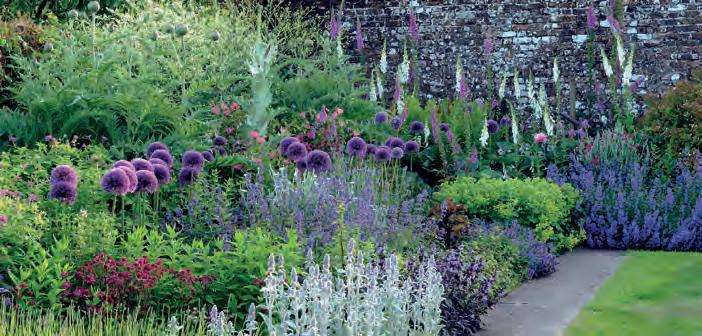


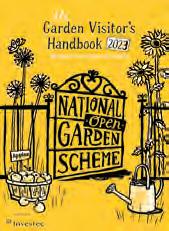


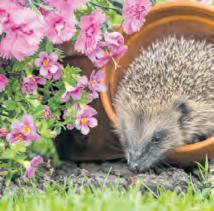

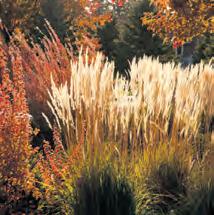
The walnut tree is both a beautiful and practical tree for gardens and if you are patient will provide a rich harvest of delicious nuts
The traditional English walnut tree, which is native to central Asia, is a beautiful and useful tree for its aesthetics and food-growing abilities alike.
It is a great tree to grow if you have the room in your garden and are looking to add a specimen or shade tree. The nuts are easy to harvest as they fall without the husk and can be gathered with a garden rake and eaten raw or used in cooking. If you have the room and the sun, it requires you may want to put the English walnut on your list of trees to consider growing. You will need some patience however before you enjoy any nuts as it will take a minimum of eight years to produce anything but there is the consolation that the tree is a thing of beauty to enjoy.
For being such an amazing tree, the English walnut is incredibly low maintenance. Providing sufficient care will ensure that your tree is healthy and supplies you with the most amount of nuts to harvest when the time comes. Just performing these few maintenance chores, like planning a watering routine, knowing when and how to harvest, and knowing the best way to fertilise, will keep you and your tree happy for decades to come.
There are many cultivars of English walnut trees, and more are being developed yearly. Each cultivar is specifically selected for a unique trait that makes it superior to the straight species. As English walnut is such a predominant food crop, most of these traits are developed to highlight needs in crop production, such as frost hardiness or nut production. The cultivars that highlight one trait are often placed on the rootstock of another cultivar or species to capture that host plant's more favourable trait. Some examples of well-known cultivars are:
• Juglans regia ‘Caspian’ - leafs of late to help avoid late-spring frosts.
• Juglans regia ‘Chaldoran’ - has medium vigor and high fruit-bearing potential which offsets the risks of late-frost damage.
• Juglans regia ‘Alvand’ - slow-growing tree with abundant fruiting potential and long flowering season to offset frost damage risk.
• Juglans regia 'Chandler' - cultivar developed at the University of California that is highly productive with medium-large, plump, light-coloured kernels that have outstanding taste. One of the most popular cultivars available.
It is easy to grow English walnuts from seed if you follow a few simple steps, but the easiest way to grow a walnut tree and the fastest way to produce a harvest is by buying a young tree. If you still want to try the seed method here it is:
• Collect walnuts after they fall.
• Remove the hulls and then place the nuts in a glass of water. Nuts that float are not viable and can be thrown away - or eaten. Good, viable nuts will sink to the bottom
How long does it take for a walnut tree to bear fruit?
The average walnut tree starts to produce nuts at an age of between eight or nine years. However, there are cases in which walnut trees start to produce about 15-22 lbs. (7-10 kg) of nuts at an age of five to seven years. Most commercial walnut orchards reach their peak production level at an age of 30 years or more.
Do you need two walnut trees to produce fruit?
All walnut varieties are self-fertile, meaning that the pollen can travel from the male parts to the female parts of the same tree and under this procedure the tree can produce nuts. Thus, a single tree can theoretically produce nuts without needing other walnut trees around.
Walnut trees can produce nuts every year, but you may experience patterns of high and low yields from year to year. Like many trees that produce nuts and fruits, walnut trees are prone to a reproductive pattern known as alternate bearing.
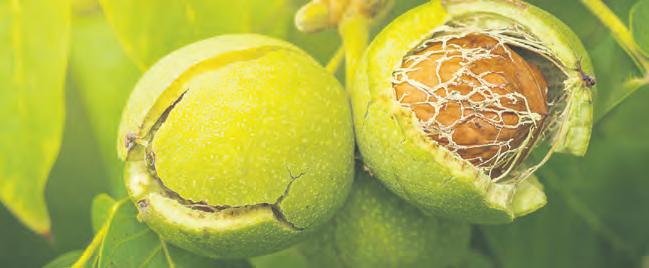
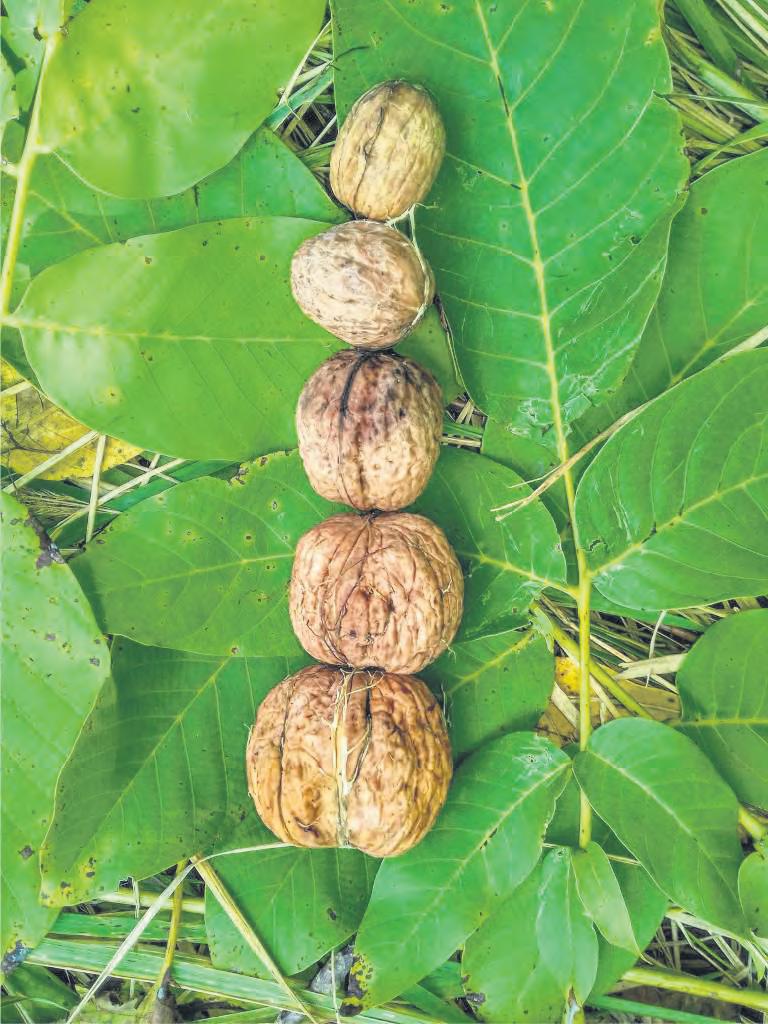
Once you are done harvesting the walnuts, you can eat them right away, but keep in mind they won't be quite like those purchased ones at the grocers.
After washing and sorting, allow the nuts to dry for two or three weeks. An excellent way to dry nuts is on a wire screen. Spread the nuts in shallow layers (no more than three nuts deep) and dry them in a cool, dry, well-ventilated area. A shed or garage is usually a good place to dry walnuts.
Walnut crops ripen in the late summer and early autumn. Harvest begins in late August and lasts through December.

of the glass. The viable walnuts will need to stratify (i.e., be exposed to cold and moist conditions that mimic winter conditions underground). Stratification can be done by placing the nuts in a sandwich bag fill sand and peat mix with a little water to moisten the mix and putting the bag in the veggie drawer in your fridge for three or four months Alternatively, you can plant the nuts directly in the ground in the fall for a less controlled result.
• Plant the nut two inches deep and wait for it to germinate.
• Care for the sapling and wait eight years to collect your first harvest of walnuts.
It will take you a minimum of eight years before you get walnutsMore than half the pumpkins grown and harvested this autumn will not be eaten. A few more creative recipes could help stop the waste.
Nothing screams autumn more than Hallowe'en and pumpkins. Perhaps the perfect symbol of the season, pumpkins are in high demand.
Fun to grow and now an almost ever present on any vegetable patch the numbers appearing in homes are also boosted by the large numbers of pick your own farms who encourage families to enjoy pumpkin picking.
However again this year a terrifying 22 million pumpkins are going to be thrown away in the UK.
Even worse than the needless waste of money is the waste of nutritious food. From the flesh to the seeds, pumpkins are low in saturated fat, cholesterol and sodium. They’re also full of valuable nutrients including vitamins A, C and E as well as fibre. There are increasing campaigns to avoid this waste and a better variety of recipes is starting to help the cause.

Use the stringy parts of your pumpkin which aren’t normally eaten to make a vegetable stock. Cook them in a little olive oil, then add other vegetable scraps such as carrot tops and onion scraps with water and seasonings. Bring to the boil and simmer for up to 60 minutes, then strain to create a delicious stock that can be added to any recipe. If you make a lot, you can freeze some in an ice cube tray for easy access to portions of stock when needed.
Homemade pumpkin butter is delicious spread on bread, crackers, pancakes and perfect for use in cooking and baking. Cut up chunks of pumpkin and boil in water for around 20 minutes. When soft, puree your pumpkin flesh in a blender or food processor. Mix with a dash of apple juice, ground ginger, ground cloves, brown sugar, cinnamon and nutmeg. Simmer and stir in a pan until thick, and chill before serving.
An autumnal risotto with great depth of flavour.
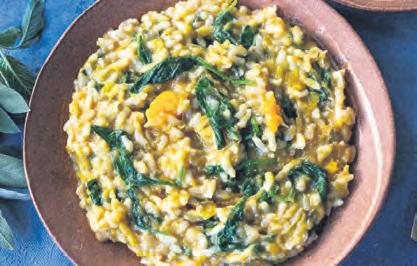
SERVES 2-4
50ml olive oil
1 leek, finely chopped 4 garlic cloves, minced 210g arborio rice 950ml hot chicken broth 235ml white wine
An excellent side to game or an earthy, robust cheese. Use in sandwiches, wraps and flatbreads – it keeps for one week stored in an airtight container.
SERVES 4
700g pumpkin, peeled and cut into dices
tbsp oil
fenugreek seeds
whole dried red chillies,
turmeric
salt
red chilli powder
sugar
2 tsp mango pickle masala
Peel, dice and wash the pumpkin, then drain and set aside. Heat the oil in a frying pan, add the fenugreek seeds and dried red chillies and allow them to pop. Next, add the pumpkin and stir over a high heat for three minutes.
Add the salt, red chilli powder and turmeric, then reduce heat, cover and cook until the pumpkin is soft and begins to fall apart.
Add the sugar to give sweetness, which balances the heat and spice and makes the pickle glossy. Finish with mango pickle.
330g pumpkin Black pepper and chilli pepper, to taste
Heat the olive oil in a large frying pan over a medium heat. Add the leeks and cook for about five minutes, or until soft. Add the garlic and cook for two more minutes. Add the rice and cook, stirring, for a few minutes until it is slightly toasted. Add
about 235ml of broth and cook, stirring, until it has been absorbed into the rice. Repeat this process with the remaining broth and the white wine.
Stir in the pumpkin, black pepper and chilli pepper, and cook for a few more minutes.
Preheat the oven 190C / Gas 5.
Peel and de-seed the pumpkin. Dice into two cms squares place onto an ovenproof sheet. Chop the rosemary and sprinkle over the pumpkin. Season and drizzle with olive oil. Roast in the oven and cook for 45 minutes.

SERVES 4-6
340g pasta of your choicce
1 small pumpkin
2 sprigs rosemary
1 clove garlic
1 shallot
double cream
1 tsp Dijon mustard
2 tsp chopped flatleaf parsley
white wine
lemon, juice only salt and freshly ground black pepper
Parmesan
As the pasta approaches the end of cooking, boil the pasta in plenty of salted boiling water according to the packet instructions.
Chop the garlic and shallot, gently pan-fry in the butter for about three minutes. Add the mustard and wine, bring to the boil. Simmer for two to three minutes. Add the lemon juice, seasoning, cream and finally the parsley.
Drain the pasta and return it to the pan. Remove the pumpkin from the oven and add it to the pasta. Pour over the sauce and mix. Add salt and pepper, to taste.
GLORIOUS NORTH DEVON. Only 9 cosy caravans on peaceful farm. Wonderful walks in woods & meadows. Easy reach sea, moors & lovely days out. £125-395pw. Discount couples. Nice pets welcome. 01769 540366 www.snapdown.co.uk


CORNWALL, NEAR ST JUST. Chalet open all year, sleeps 2/4. Nearby gardens, coast, golfing. Prices from £350pw. 01736 788718

BOSWORLAS NEAR SENNEN/ST JUST, CORNWALL. Cosy Cottage, rural views, Sleeps 2-4 01736 788709 www.bosworlas.co.uk





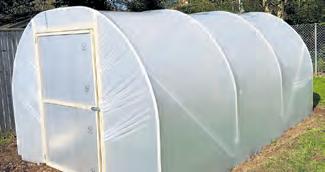

WYE VALLEY/FOREST OF DEAN. Fully equipped 4-star single storey cottage. Two bedrooms both en-suite. Central heating/bedlinen provided. Rural retreat with shops/pubs one mile. Short breaks available. Warm welcome. Tel: 01594 833259 www.cowshedcottage.co.uk
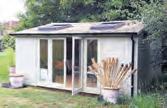
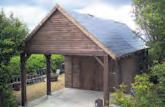


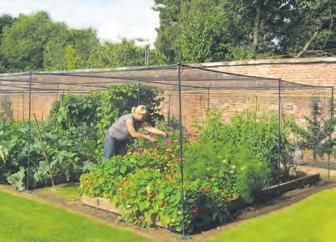


NORTH DEVON NEAR CLOVELLY. 3
cottages situated in 12 acres of idyllic countryside. Sleeps 2-4. 1 Wheelchair friendly. Prices from £190p.w. Brochure: 01237 431324 www.foxwoodlodge.co.uk foxwoodlodge@outlook.com
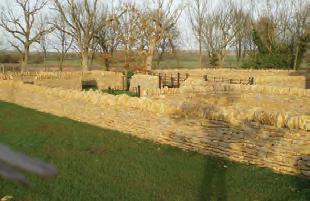
The
enduring
all British
it's essential to keep plants strong and shapely by pruning out old and weak shoots - and you can start in November
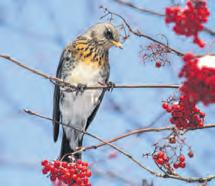
On a day when the weather is neither icy nor frosty, arm yourself with a sharp pair of secateurs and don a pair of tough gloves to prune your rose bushes. Pruning will encourage them to produce lots of flower buds on a well-shaped framework of branches with an open centre.

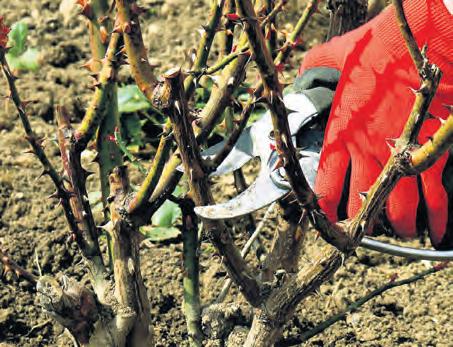
As it’s the younger stems that tend to produce the best flowers, the aim is to prevent the plant from becoming congested.
Remove any dead, damaged, diseased or weak-looking stems completely. Then cut back the most vigorous stems to within 25-30cm or three or four buds above last year’s cut, and the thinner stems back a little harder. Always cut to an outward-pointing bud, making a sloping cut about six mm above the bud.
The
from one of our
relevant to where
of the
Removing
As thorns don’t tend to rot, put the dead material in the dustbin instead of the compost—especially if the plant has been infected by disease.
Winter is the key rose pruning time to cut back most varieties, except rambling roses, which are pruned in summer immediately after flowering. There’s no set timings when it comes to pruning . It needs to be done by February and there’s an increasingly popular view that November pruning can give the plant a stronger start next spring. The basic principles of pruning roses are the same as pruning anything else: cutting back hard will promote the strongest growth, while light pruning will result in less vigour. The other basic rules include cutting to an outward-facing bud to prevent compacted growth, and removing closely positioned stems that might rub or compete for space.
Also remove stubby 'snags' (short, dead lengths of stem with no growth on them) and thin, twiggy stems, which are unlikely to produce anything worthwhile in terms of growth and flowering potential.
I
This
This is a
(send
choose
issue)
region by ticking the box:
Cotswolds * Devon * Dorset * Somerset * Hampshire *
Aim
For roses planted in particularly windy or exposed areas prune shrub roses by a third of their size in mid to late October; once the last of the roses have faded. This prevents ‘wind rock’ which is when the rose becomes loose at the base where it meets the soil, due to wind exposure. For standard roses prune lightly to defend against strong winds.
Climbing roses are vigorous selections from the same breeding as bush roses. Roses from other groups can be climbing roses, hence you'll come across English climbing roses, climbing hybrid tea roses and more.

In winter, once a main framework of stems has been trained across their support, the sideshoots of climbing roses can be cut back close to the main framework.
Bush roses include cluster-flowered floribundas and large-flowered hybrid teas, and have been bred for their ability to flower freely on strong new growth made during the current growing season. This means they can be cut down hard every year to keep plants compact.
Meanwhile, miniature roses simply need to be encouraged to produce thicker stems that will be topped with blooms, while any thin, unproductive twigs should be removed completely.
out to Alro
Country Gardener, Mount House, Halse, Taunton,
3AD.
to receive.
Mark Hinsley urges us to consider the wider importance and implications of the trees which surround us.
I once found in a book an 11th Century BC Egyptian tomb painting showing a couple of men carrying a root-balled tree slung from a pole between them.
Strange then that, over 3000 years later, the Arboricultural Association should be holding a conference entitled ‘What is a Tree?’
You would have thought we had worked it out by now!
However, although arboriculture as a profession is very old, arboriculture as a science is relatively new. When I was a student from 1975 to 1979 we were taught ‘cutting edge’ arboriculture, yet what we learned was little better than witchcraft – it had no real basis in science and many of the practices are now outlawed as harmful to trees. We used to consider a tree to be a single entity - that view has changed!
“Money makes the world go round” – does it?
Nature has a different currency and it is carbohydrates or, simply, sugar. The world is powered by sugar and what we call a tree can be likened to a sugar producing corporation which sets out to dominate its local market.
The production of sugar through photosynthesis produces by-products, such as oxygen, and most life on earth has evolved to live off those by-products, but they were never the aim of the ‘tree corporation’; its business is sugar. In a similar vein, brewers never set out to make marmite! The production part of the ‘tree corporation’ is the leaf.
But, as with any large corporation, there is a support system that enables the organisation to continue to position that leaf in the optimum location to produce. However, the parts of the system must be paid – in sugar.
The ‘tree corporation’ has an human resources department. Fungi sit in the sap stream in all the branches. As long as they get their sip of sugar, they do nothing. If the sugar levels drop, they turn into parasites and kill the branch. Inefficient branches are thereby shut down. However, it does not end there.
Clean up gangs of fungi and bacteria come in to break the branch up, so it falls to the ground to be absorbed back into the soil – these guys are paid with sugar left in the branch cells.
Once in the soil the procurement department takes over. Mycorrhizal fungi on the corporation’s root system massively increase its ability to source and convert resources to the building blocks the ‘tree corporation’ needs to maintain its support and transport infrastructure and make its sugar. This department works for sugar.
Some elements of the fungi will protect the corporation from aggressive competitors trying to move in on its market – sort of corporate lawyers and mafia hitmen rolled into one. If you want to win big you must be prepared to play dirty in this fiercely competitive environment. None of these groups work for nothing. In mature specimens fungi will go through the redundant areas of the organisation stripping out the old, inefficient and unnecessary, passing it down to the procurement department to redistribute.
In the competitive world of the ‘tree corporation’ nothing can go to waste.
So, what is a tree? Fundamentally, it is a ferociously competitive sugar producing organisation. We romanticise trees; we even deify them. Our lives are full of them. We live in dwellings made from them, we use them for heat, we make bats out of them, we use them for transport, we breathe their by-product.

What is a tree to us? Are we the shareholders? But if we take too much dividend, we bankrupt the company –and then where will we be?
Mark Hinsley runs Arboricultural Consultants Ltd which offers a wide range of tree
services.
